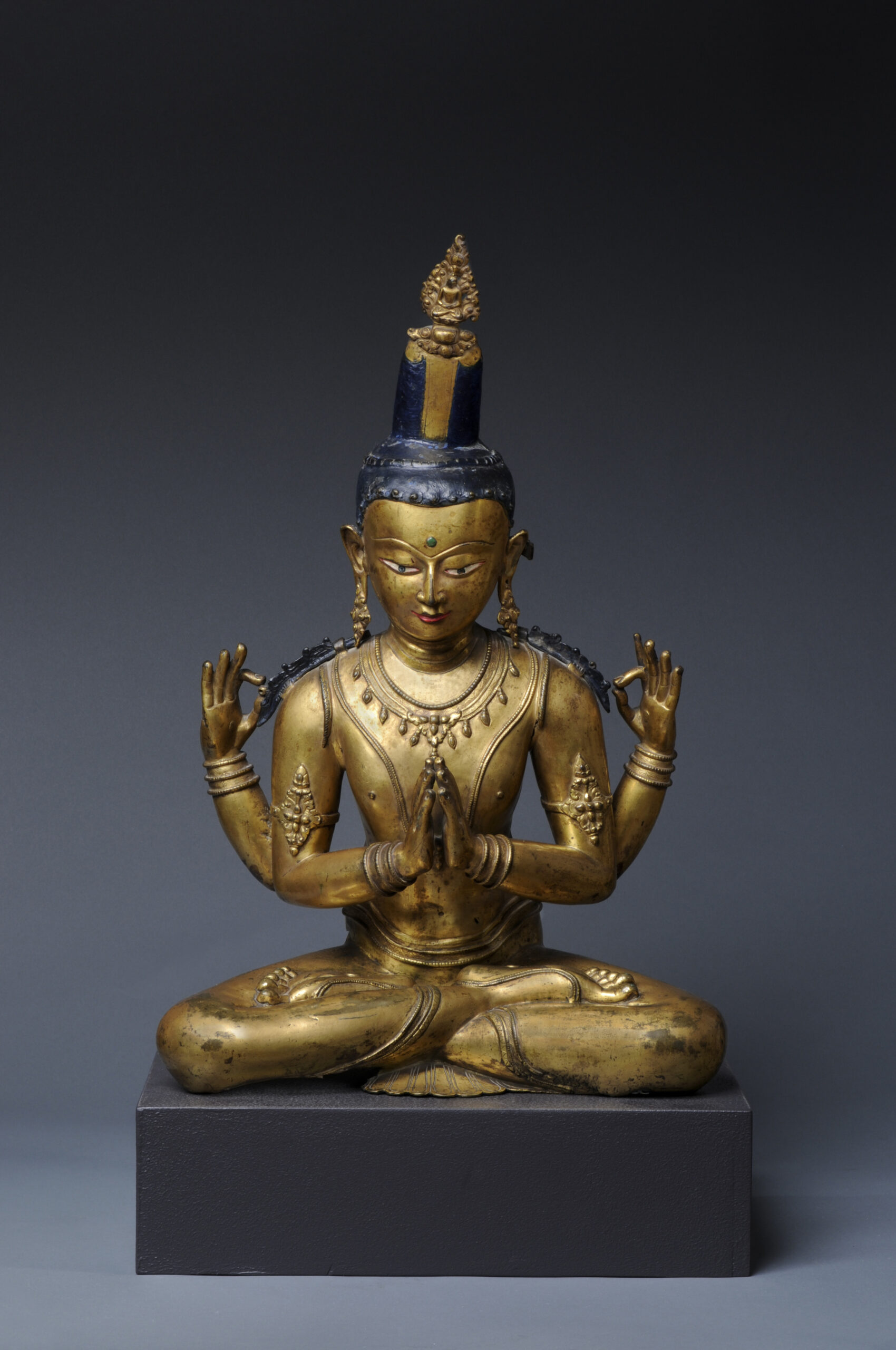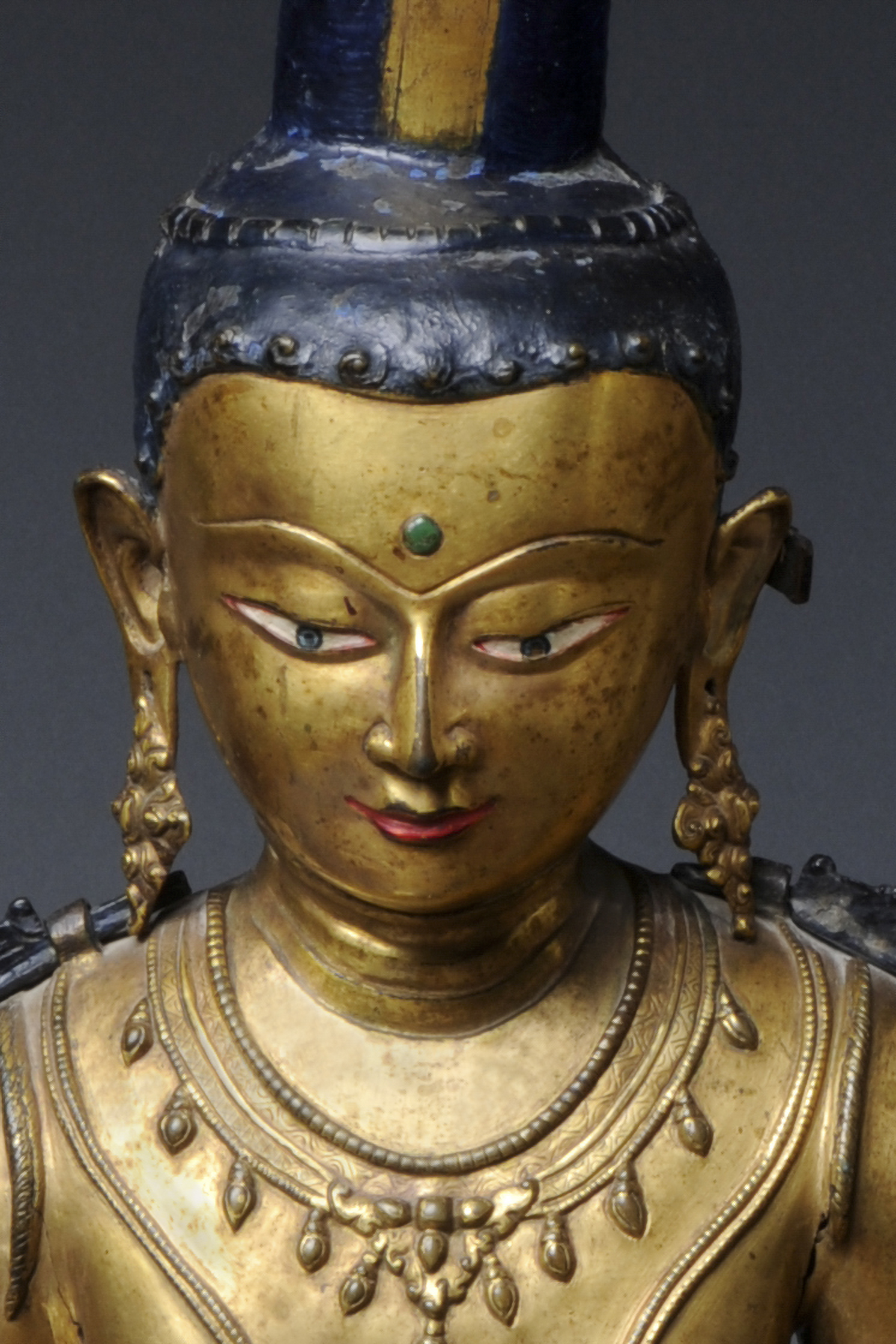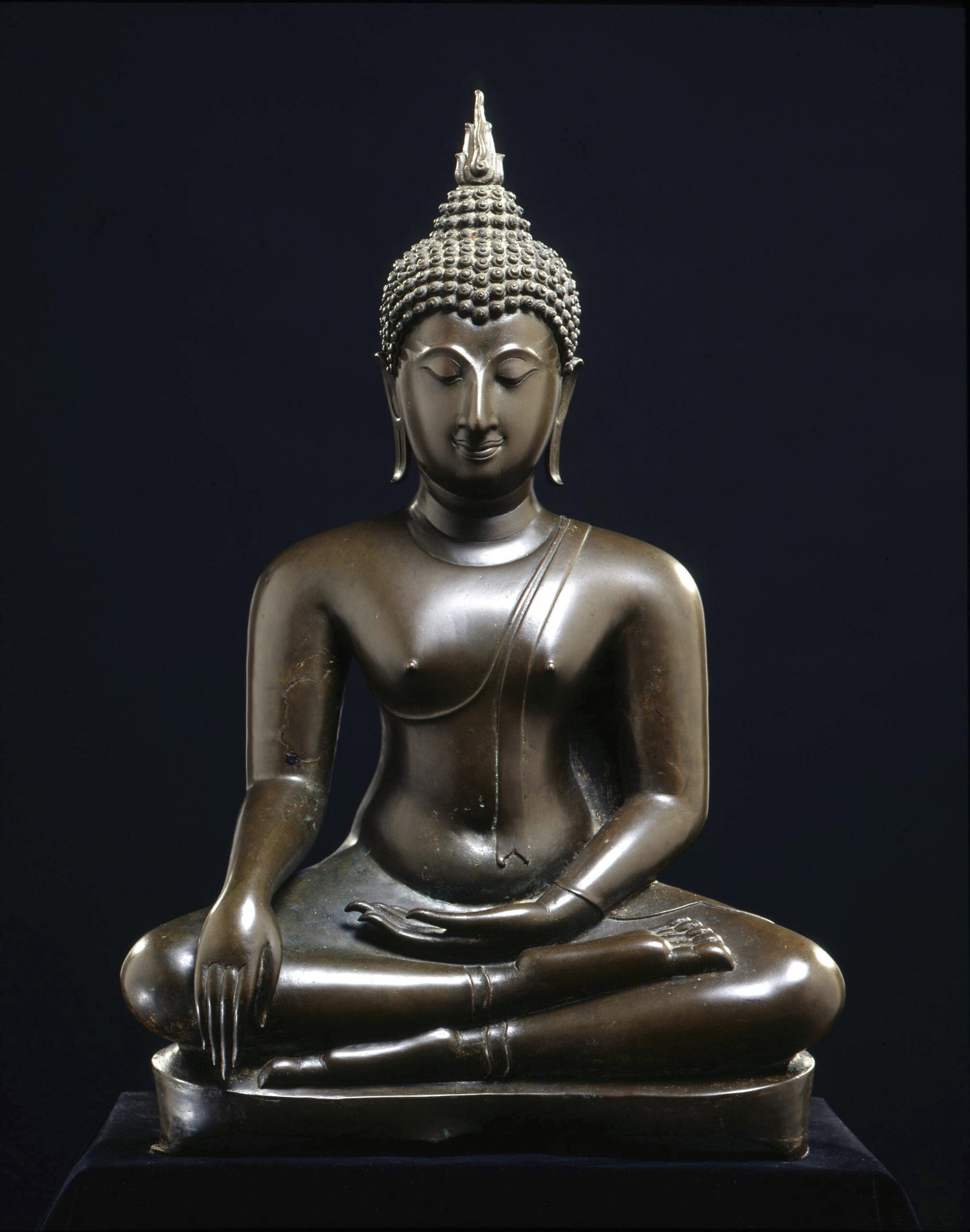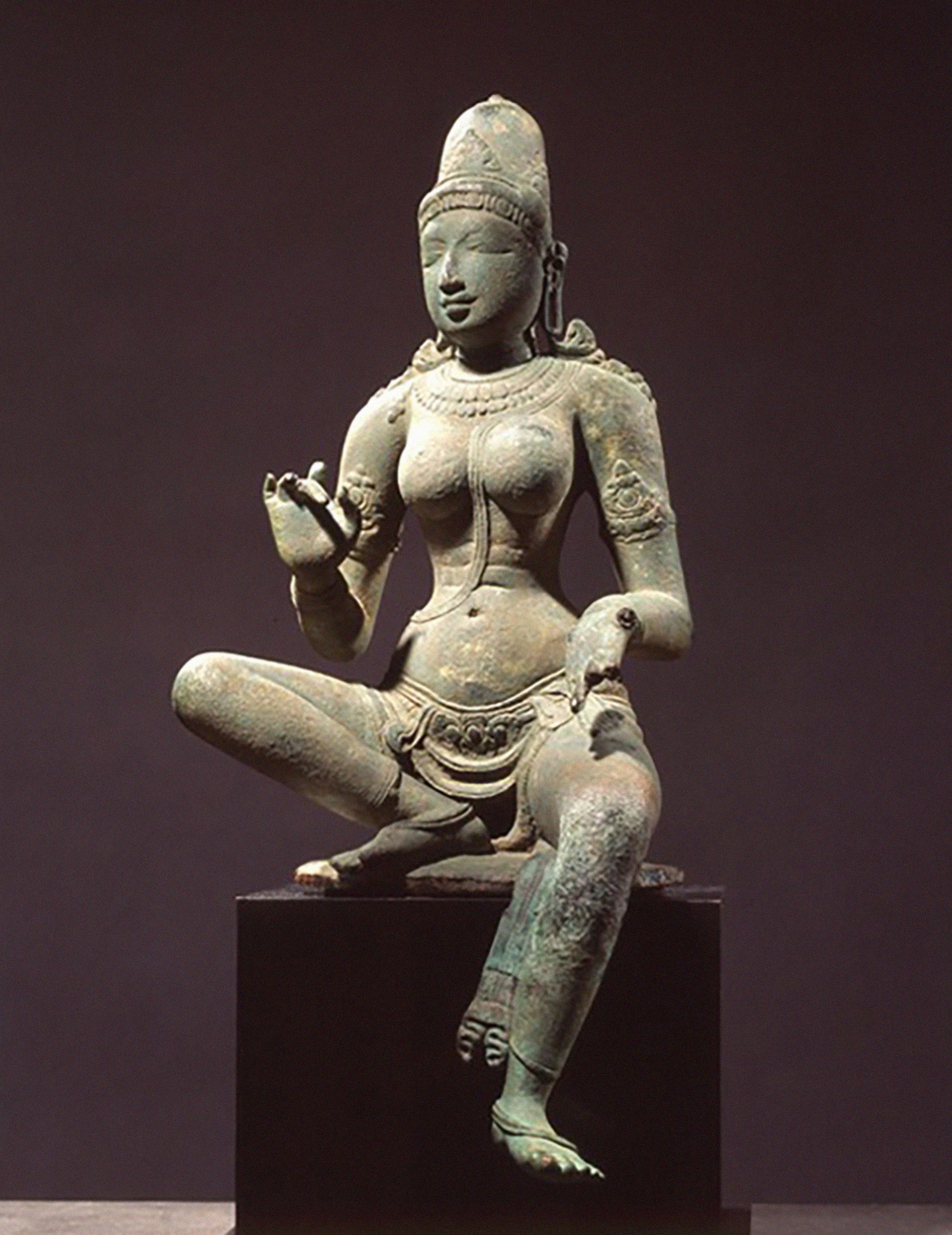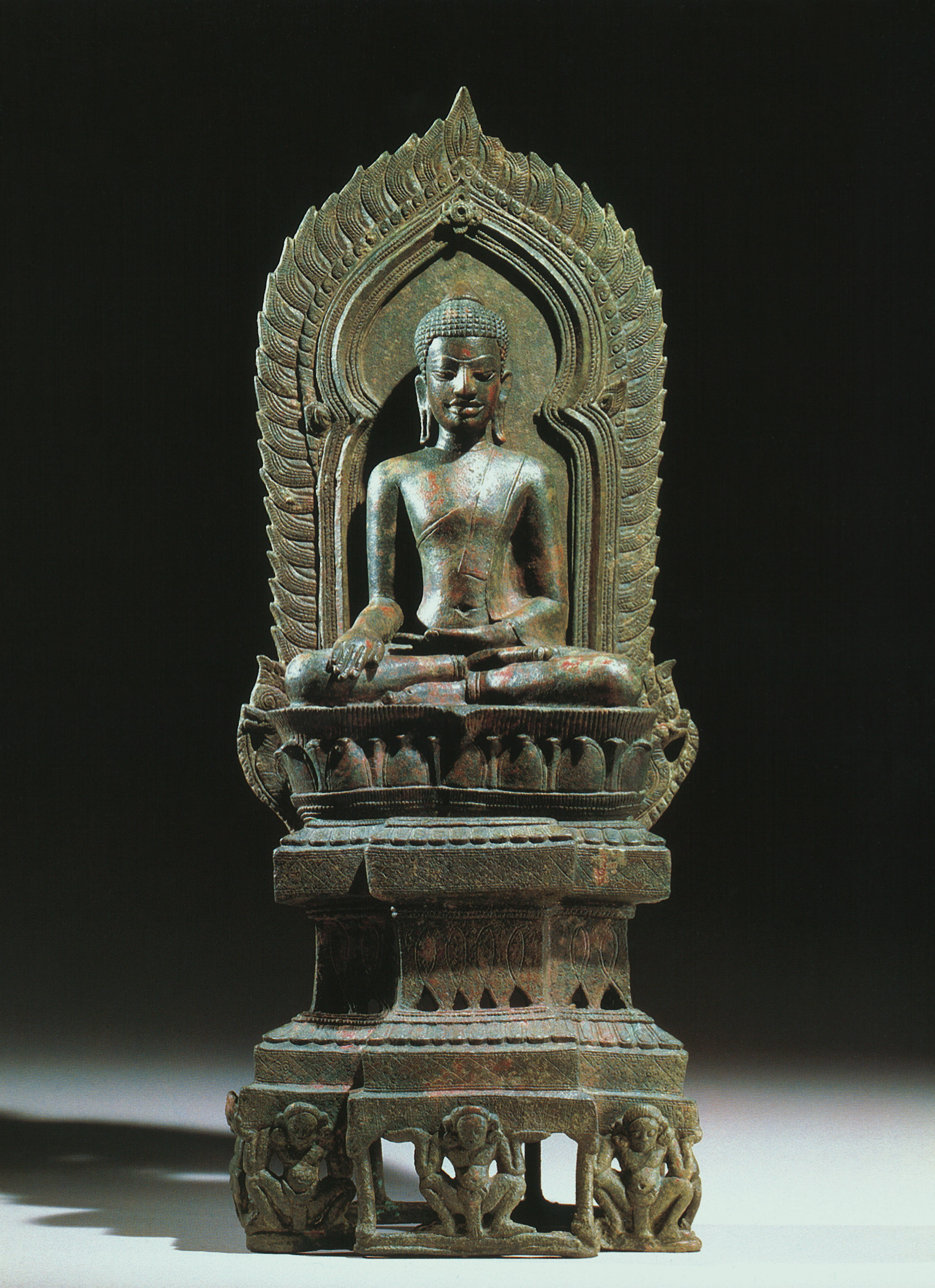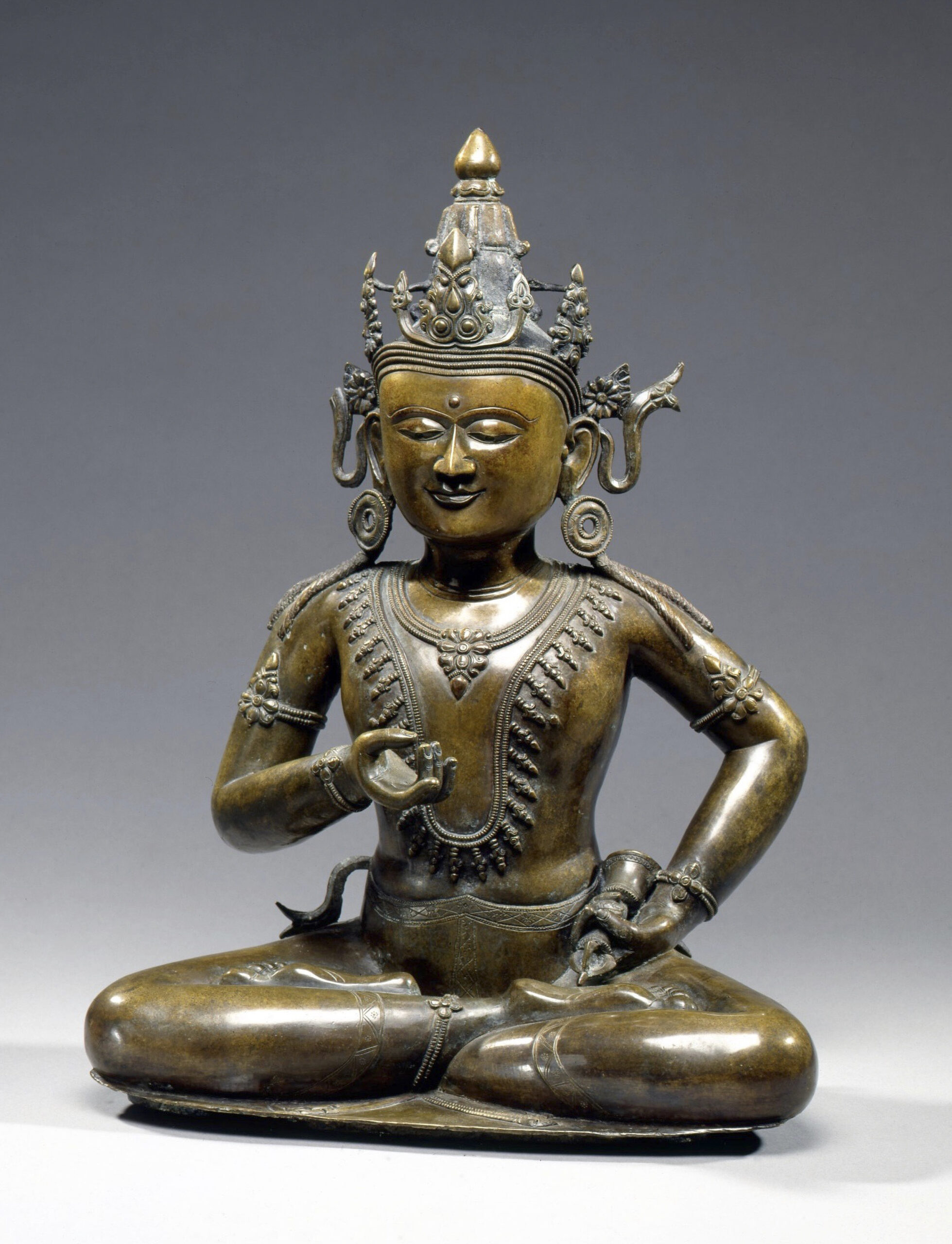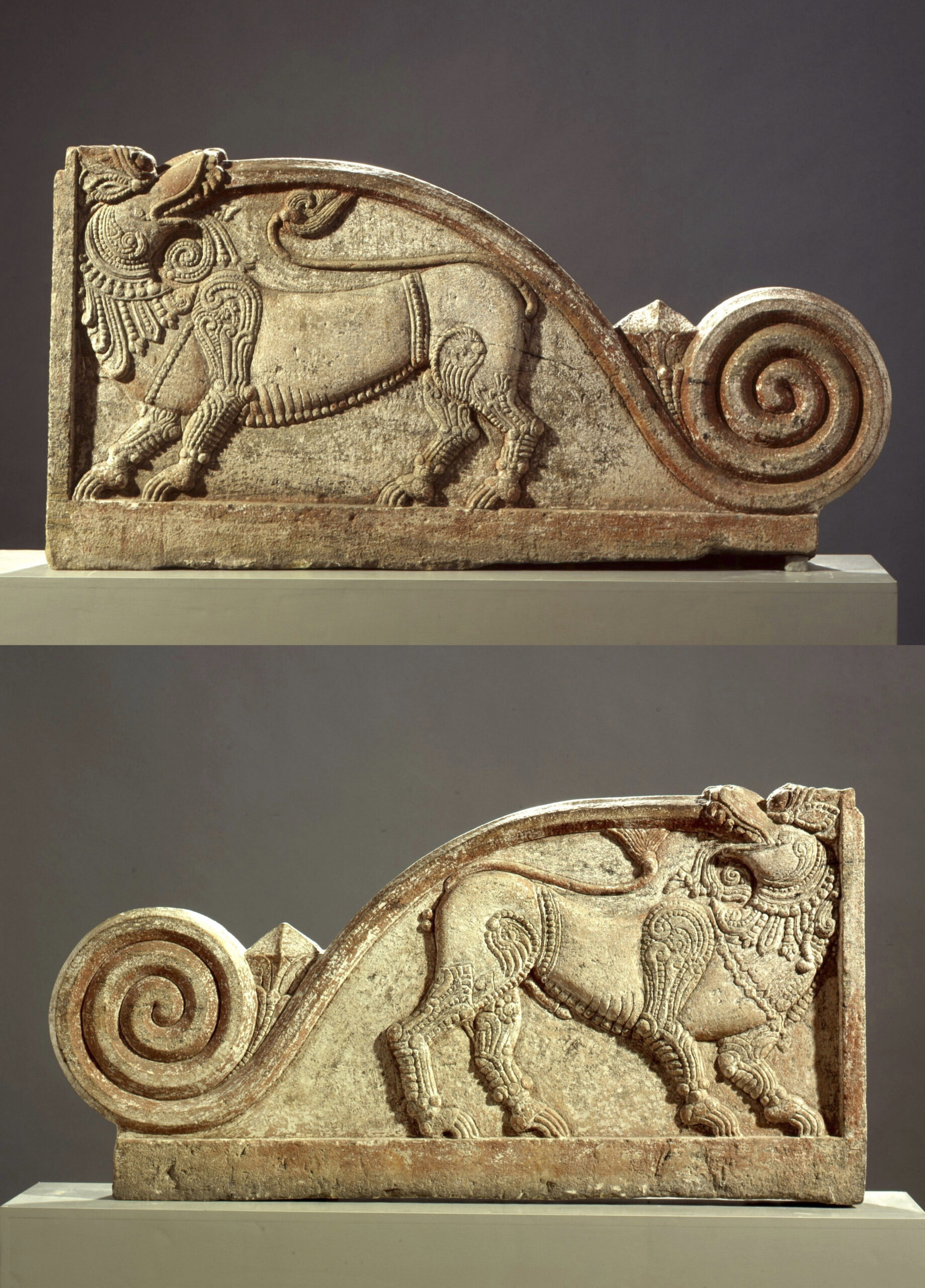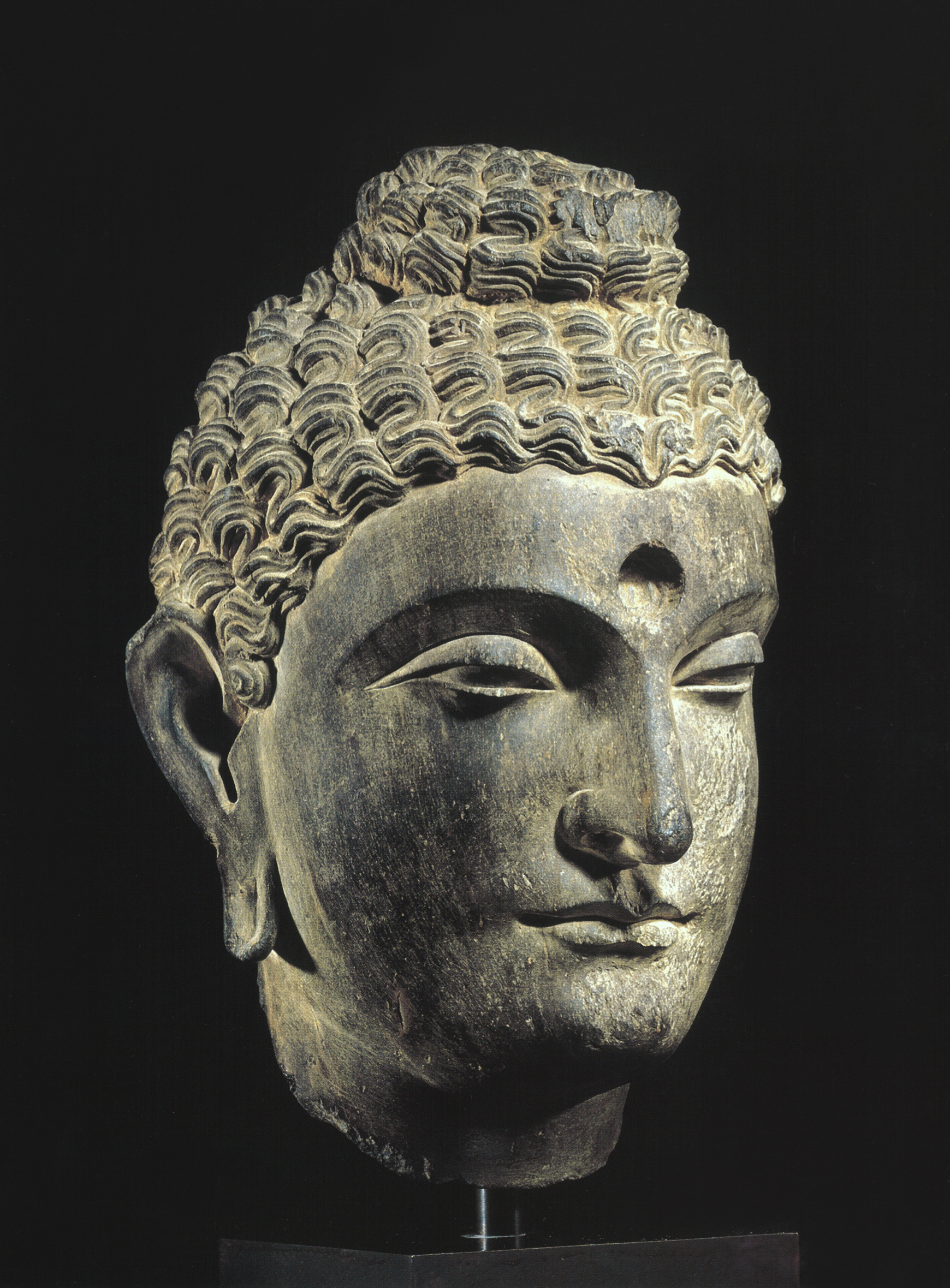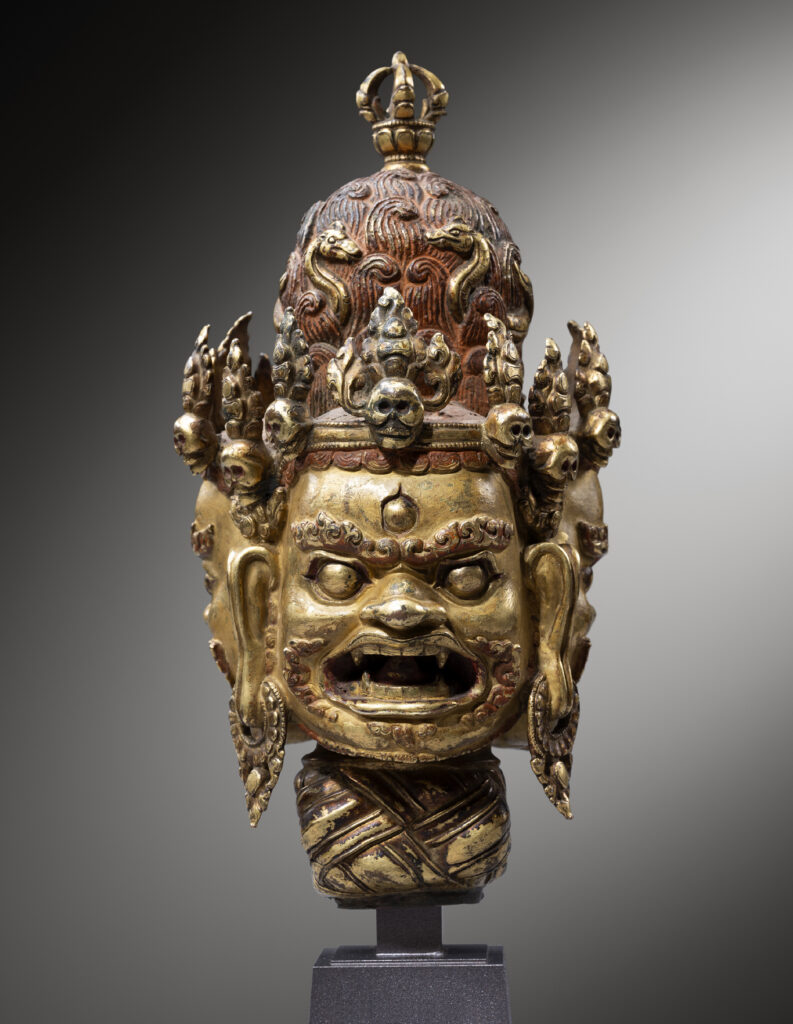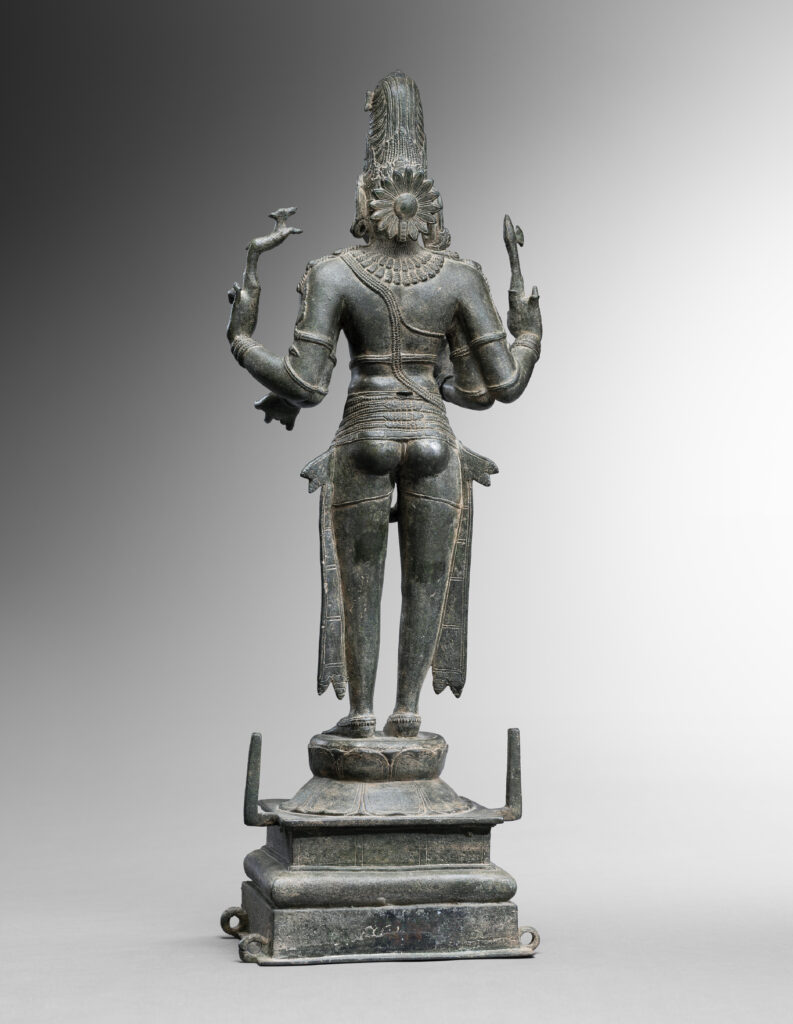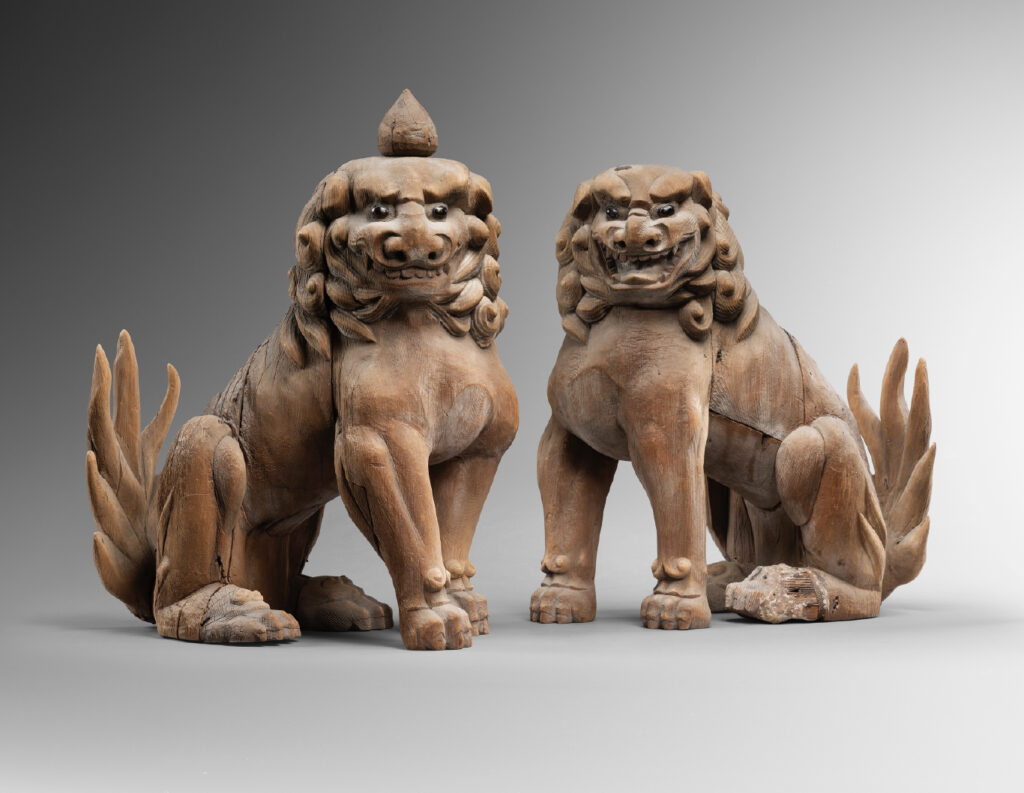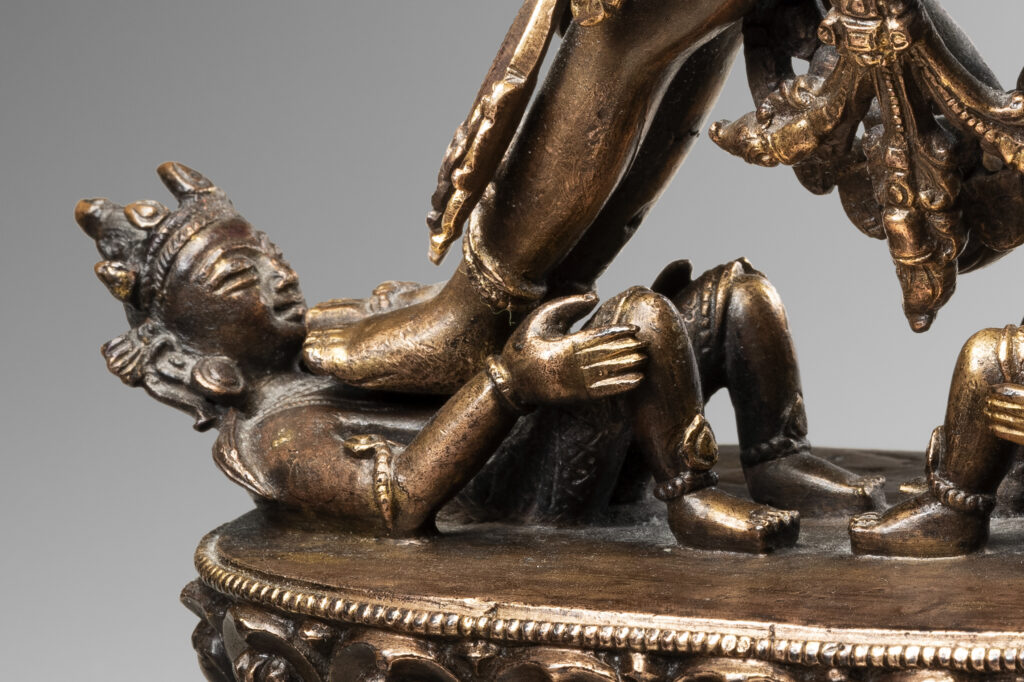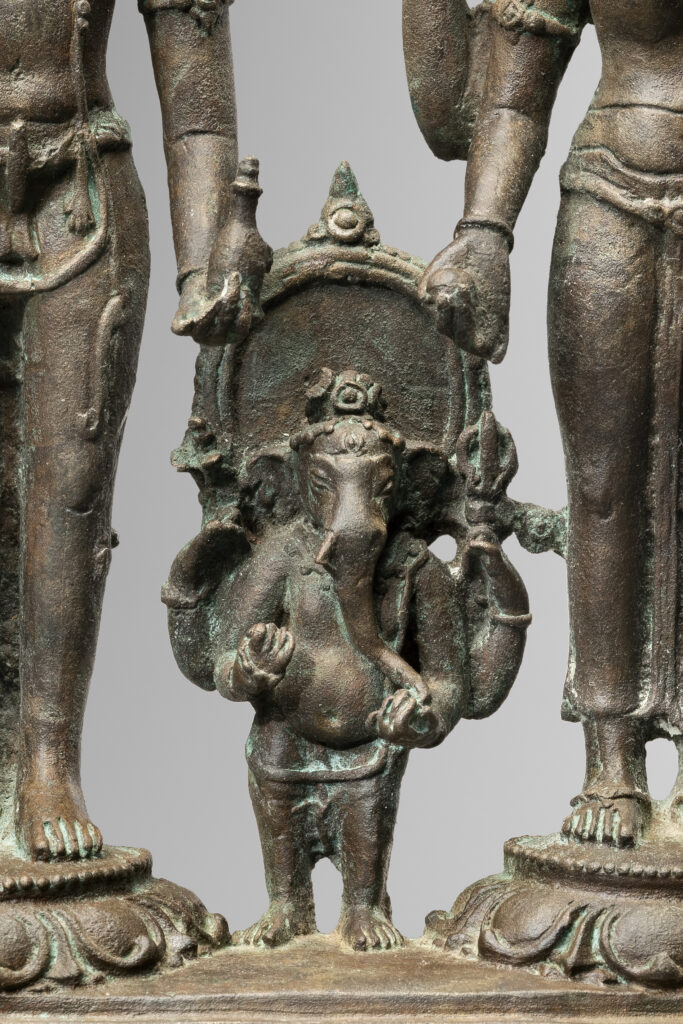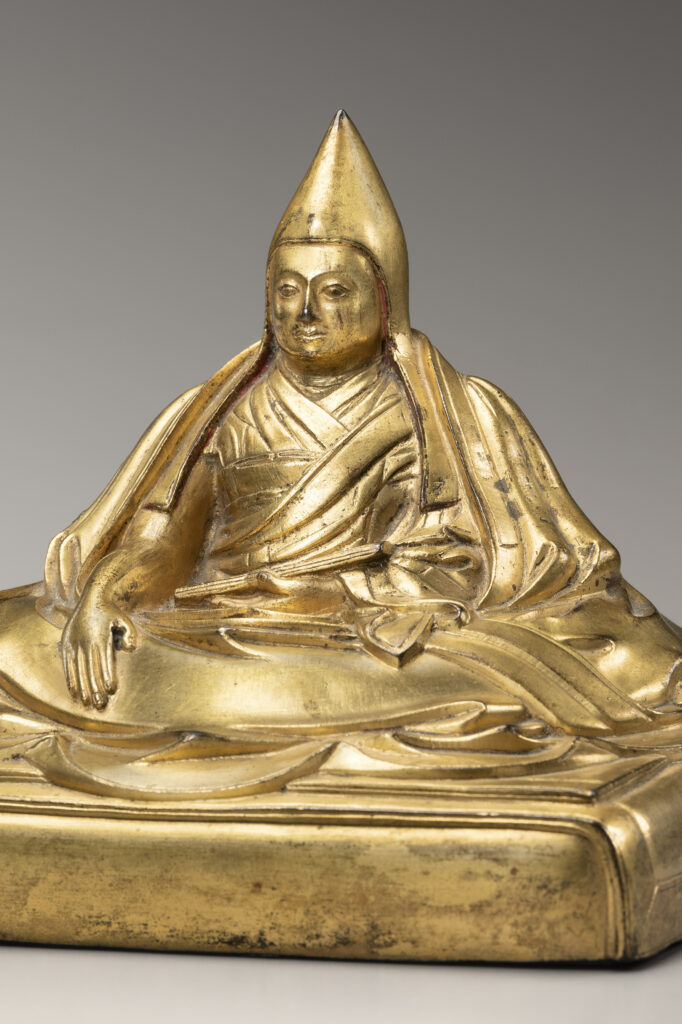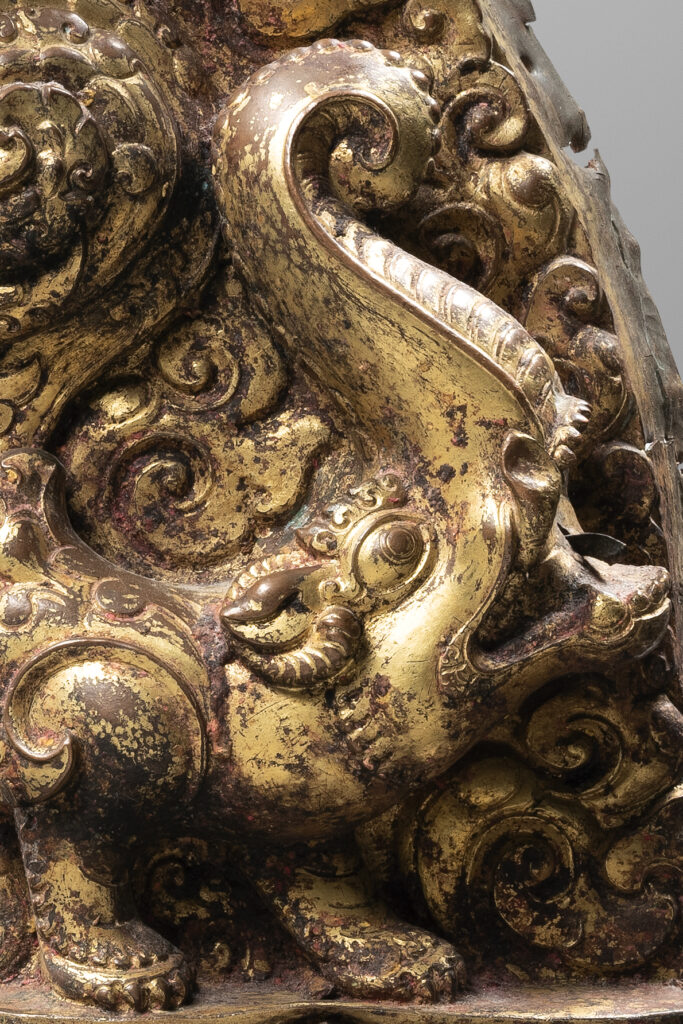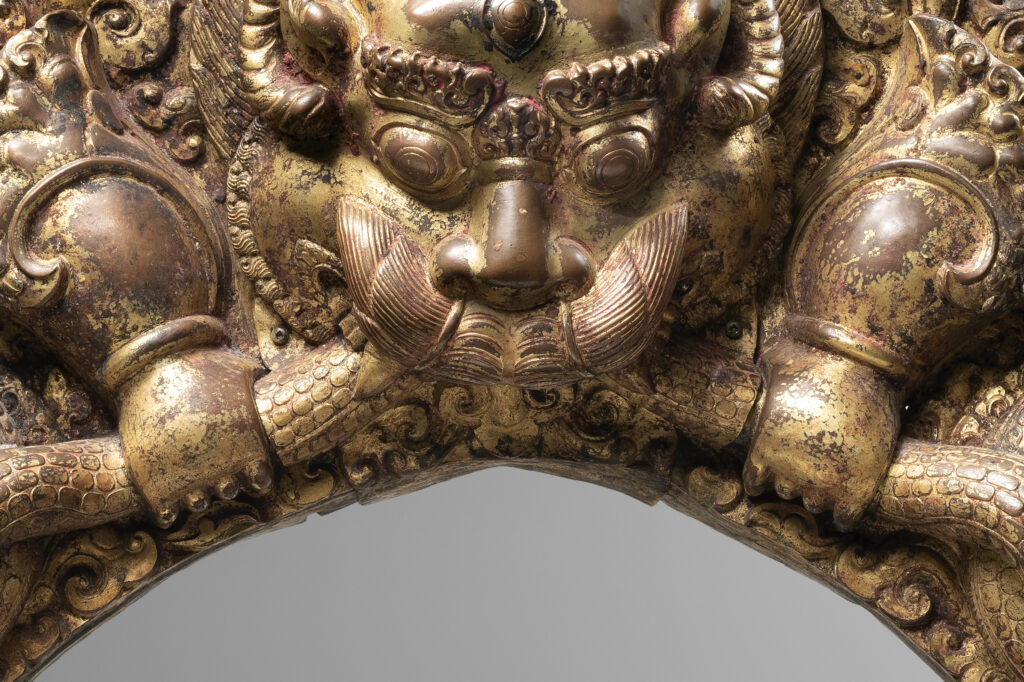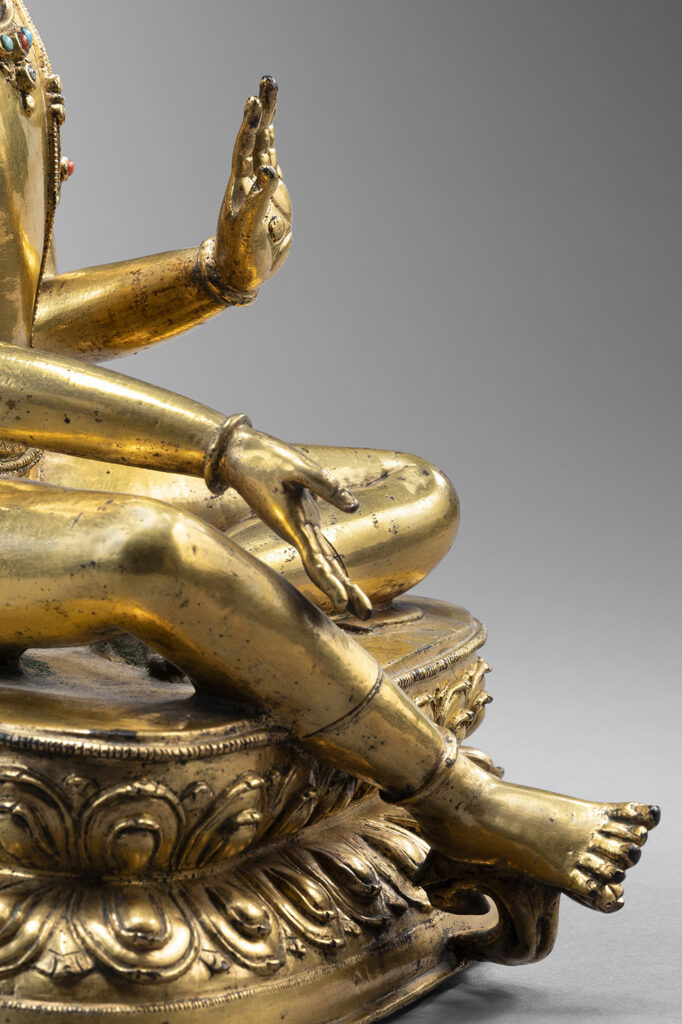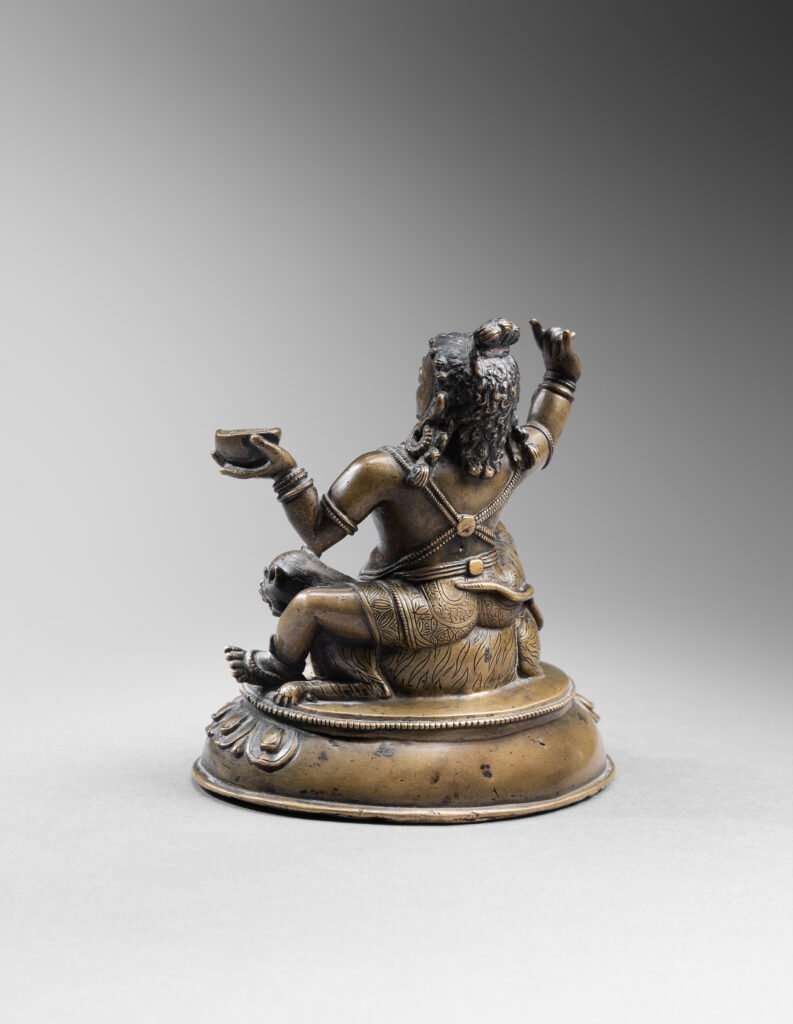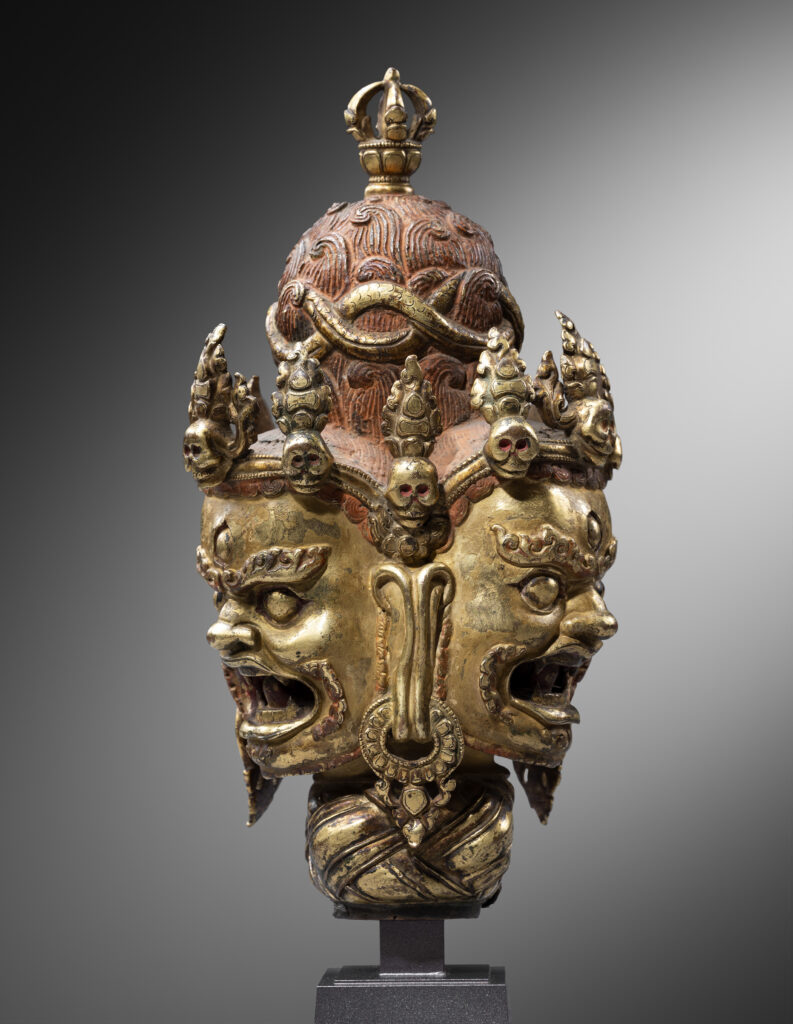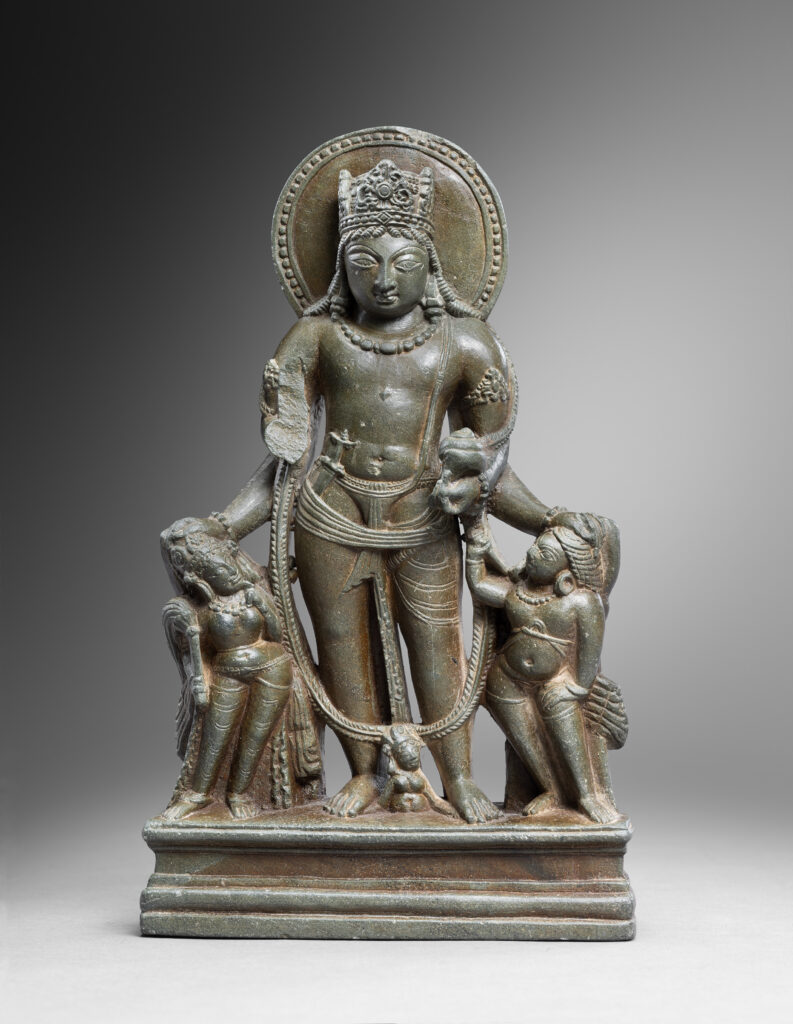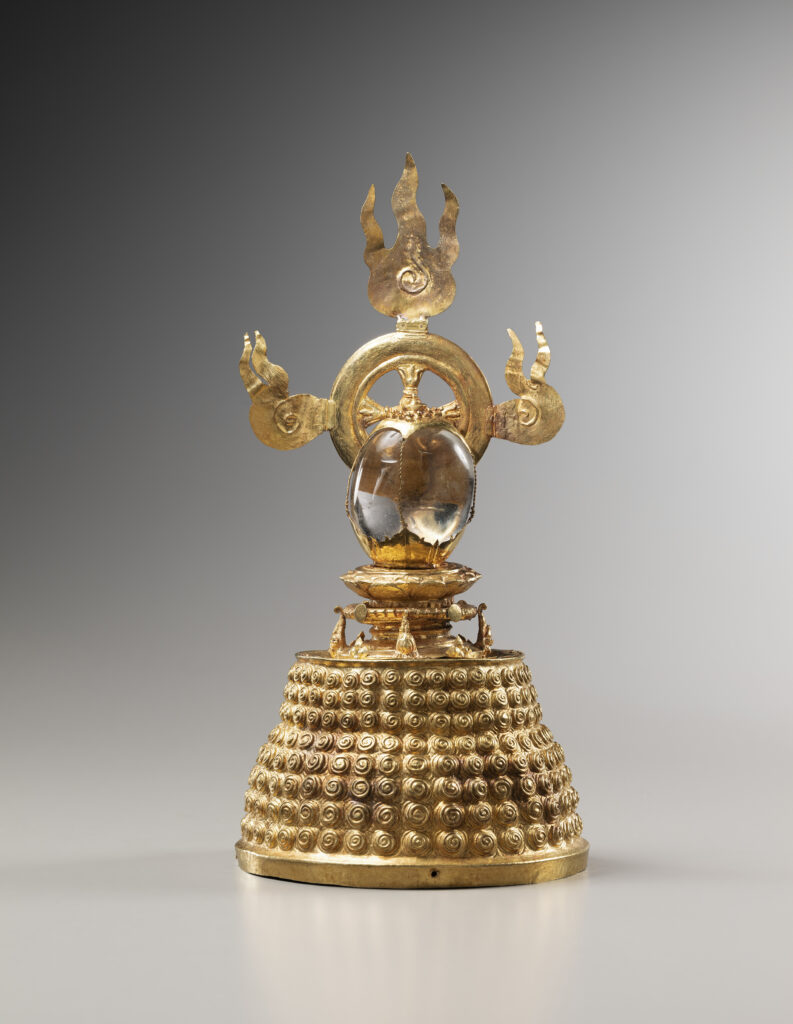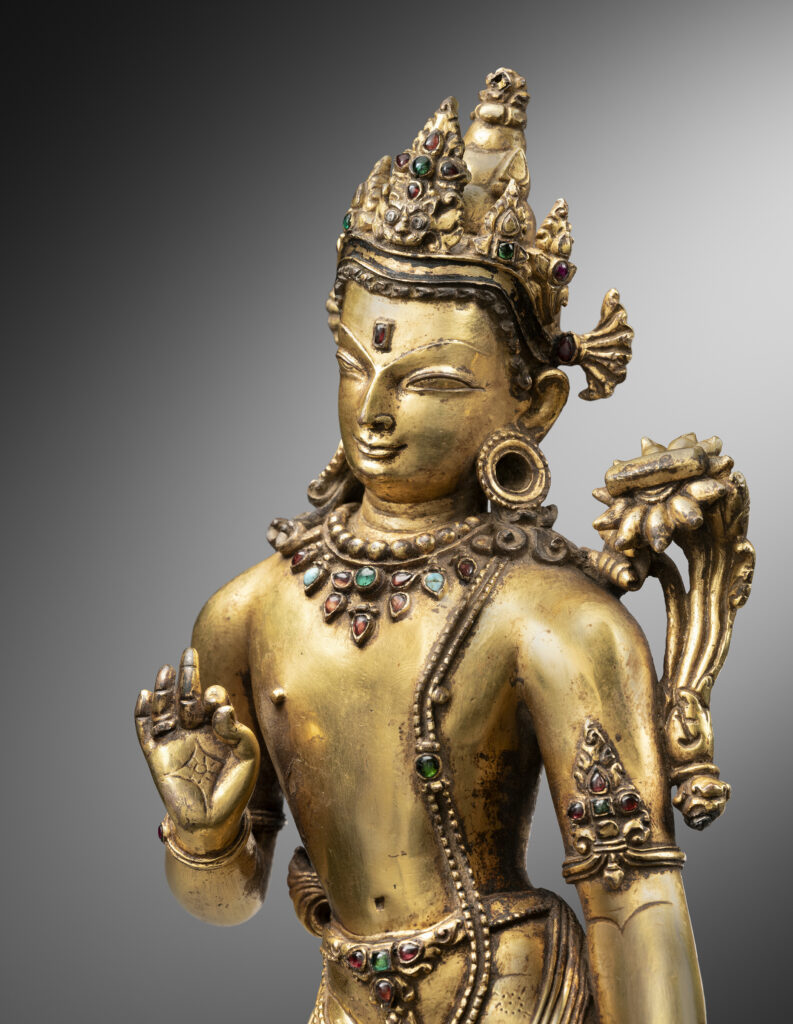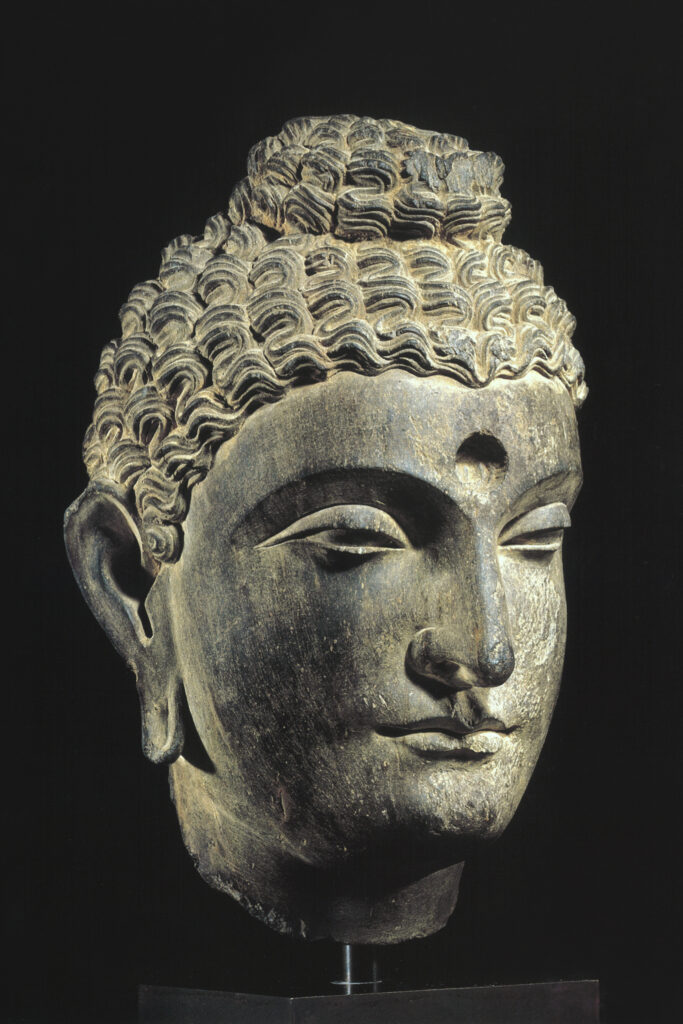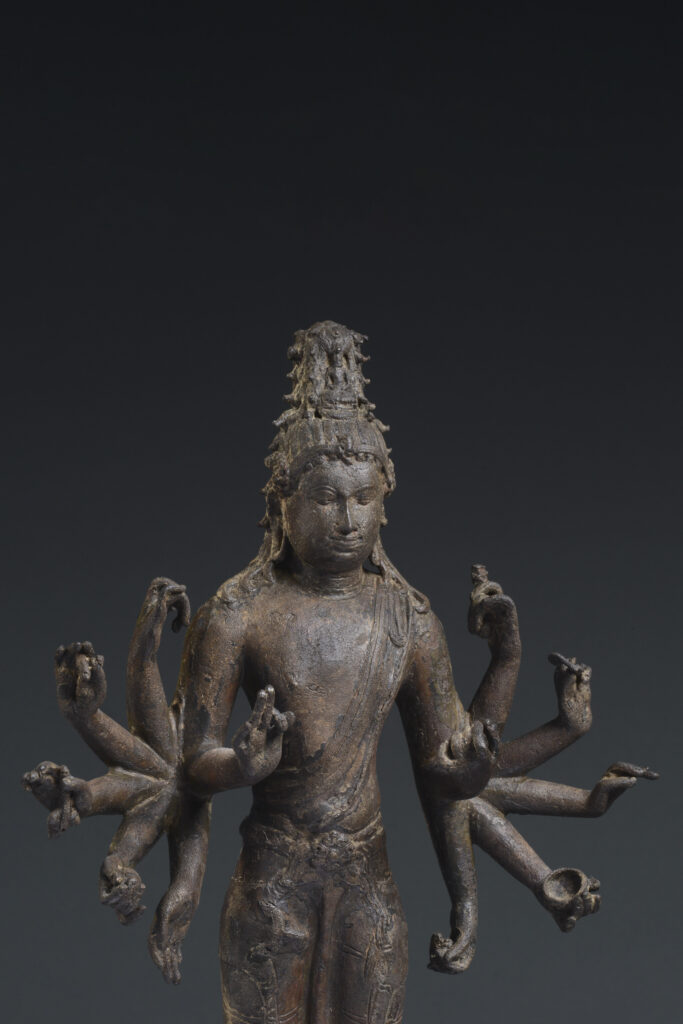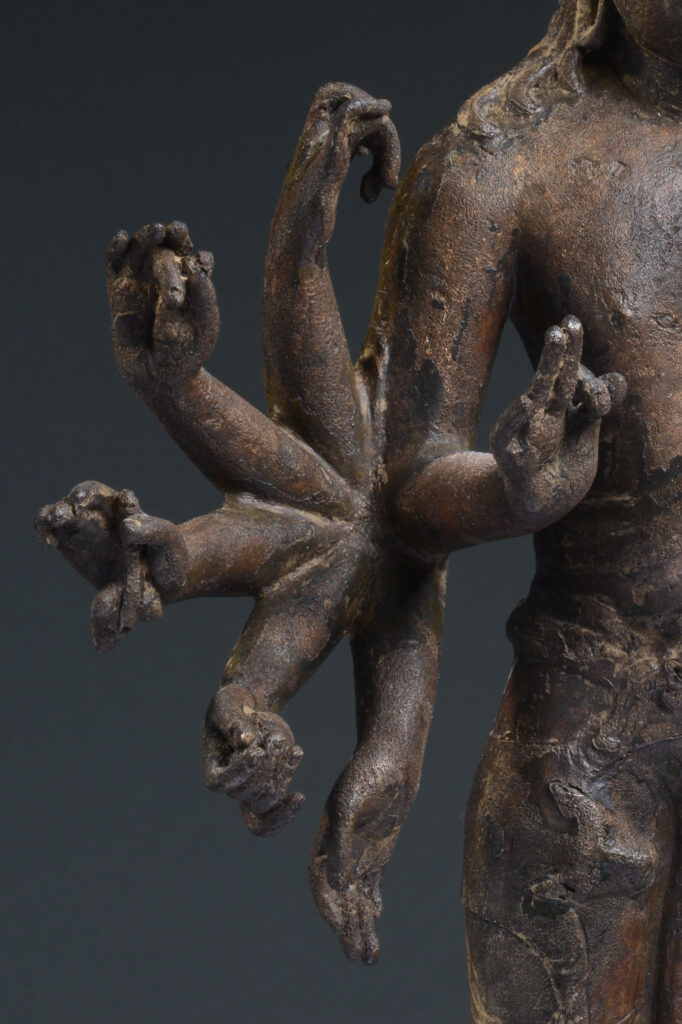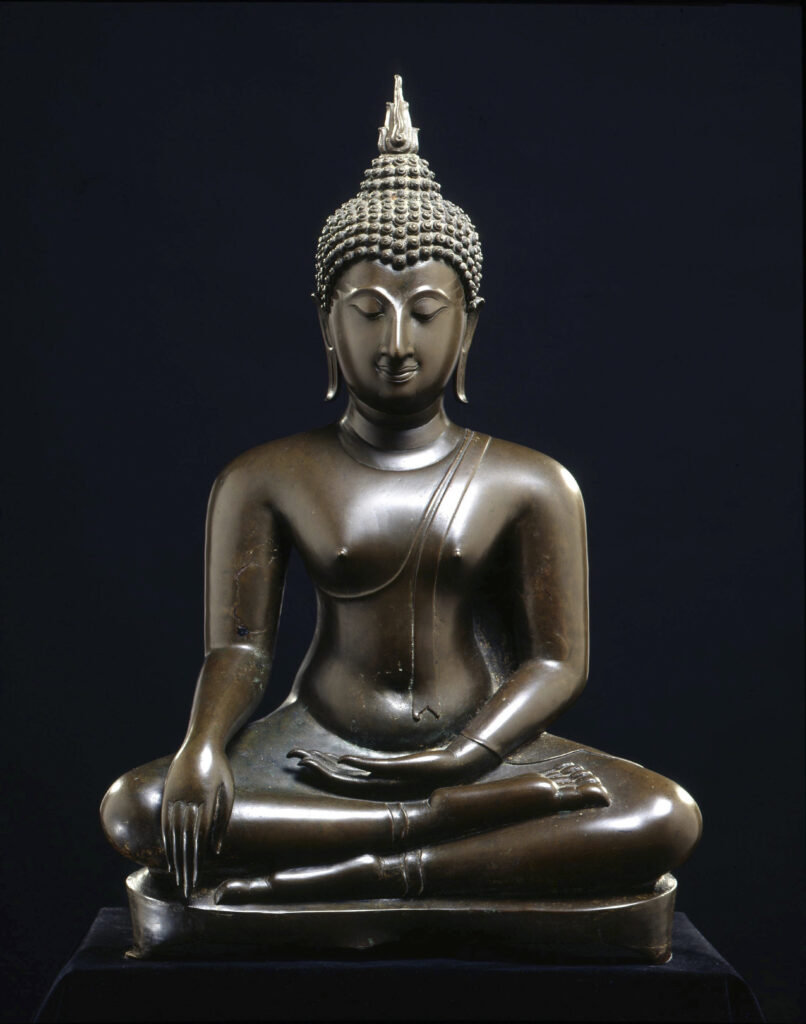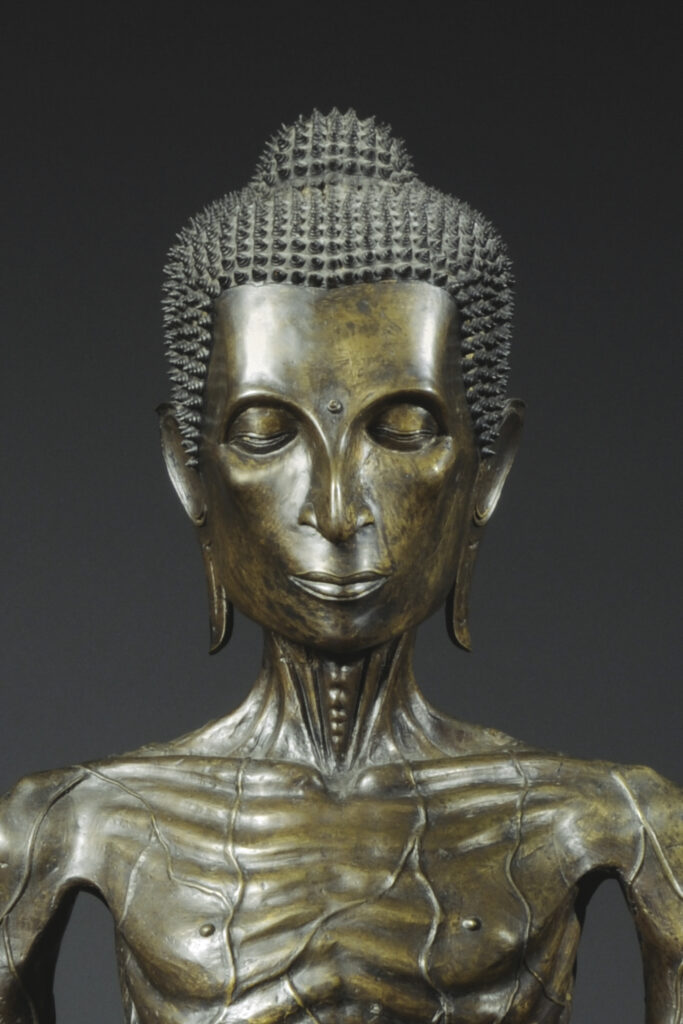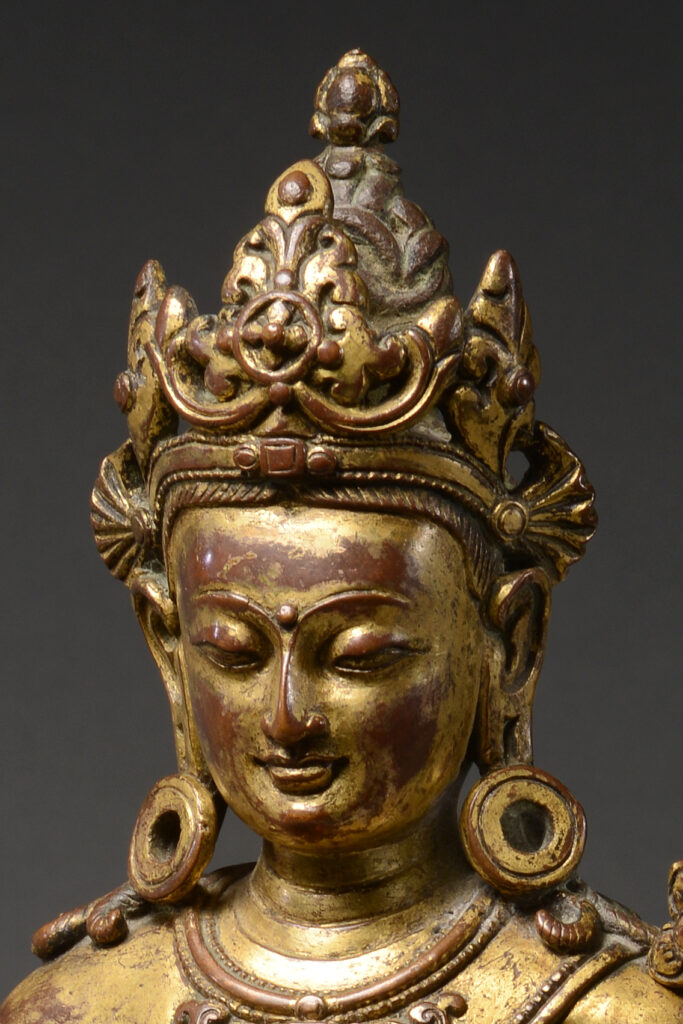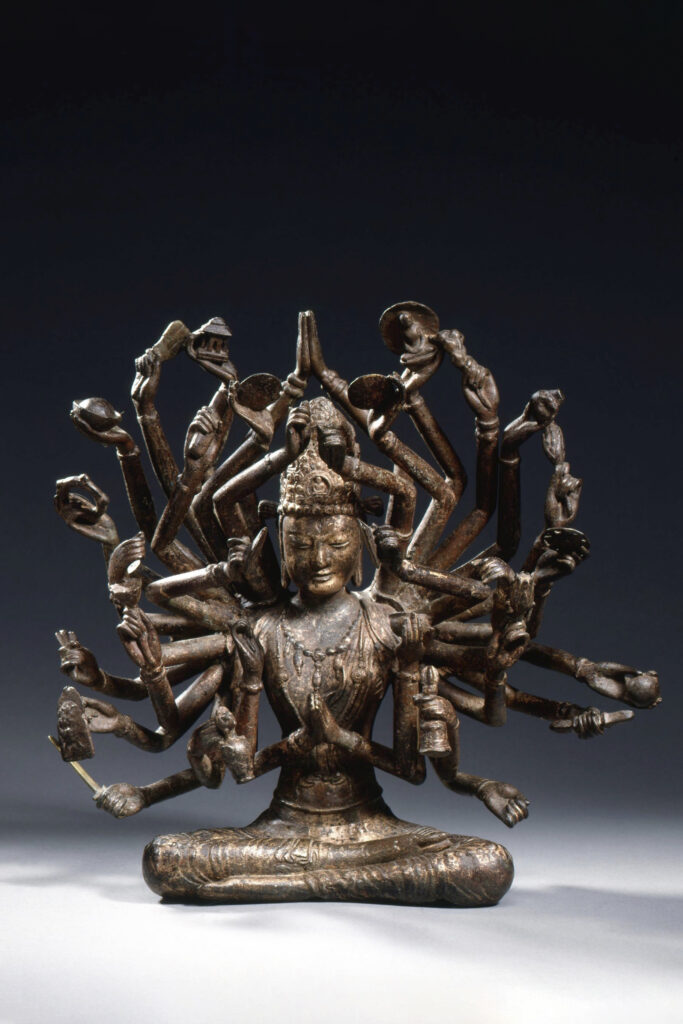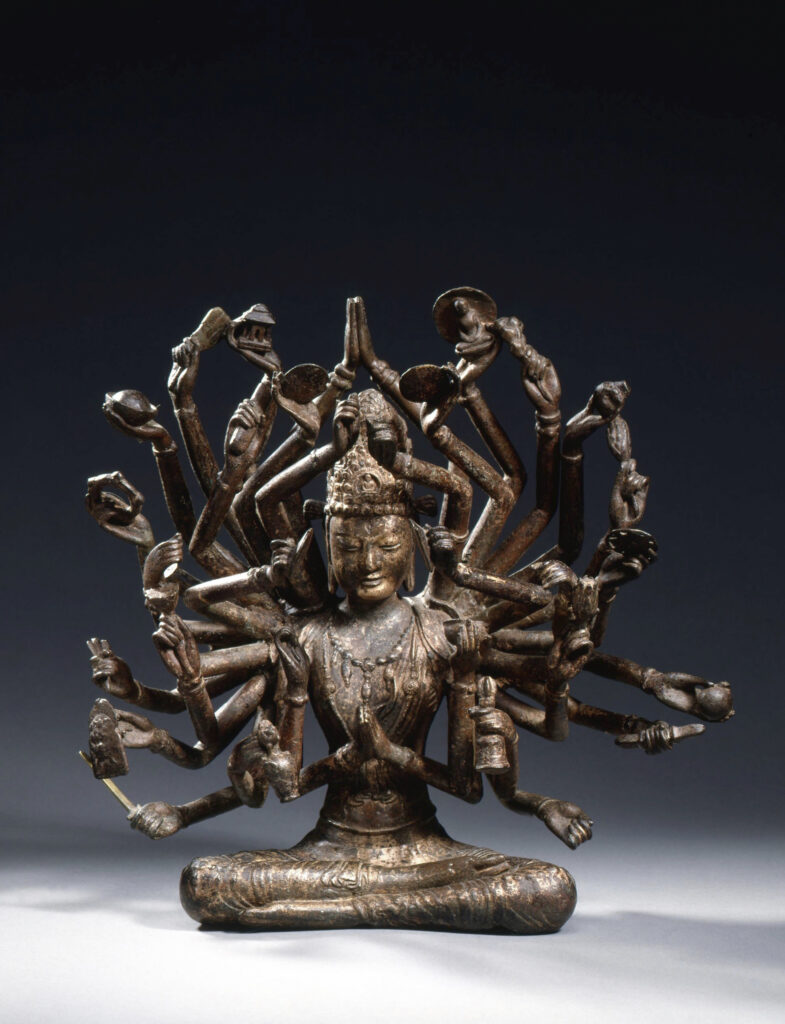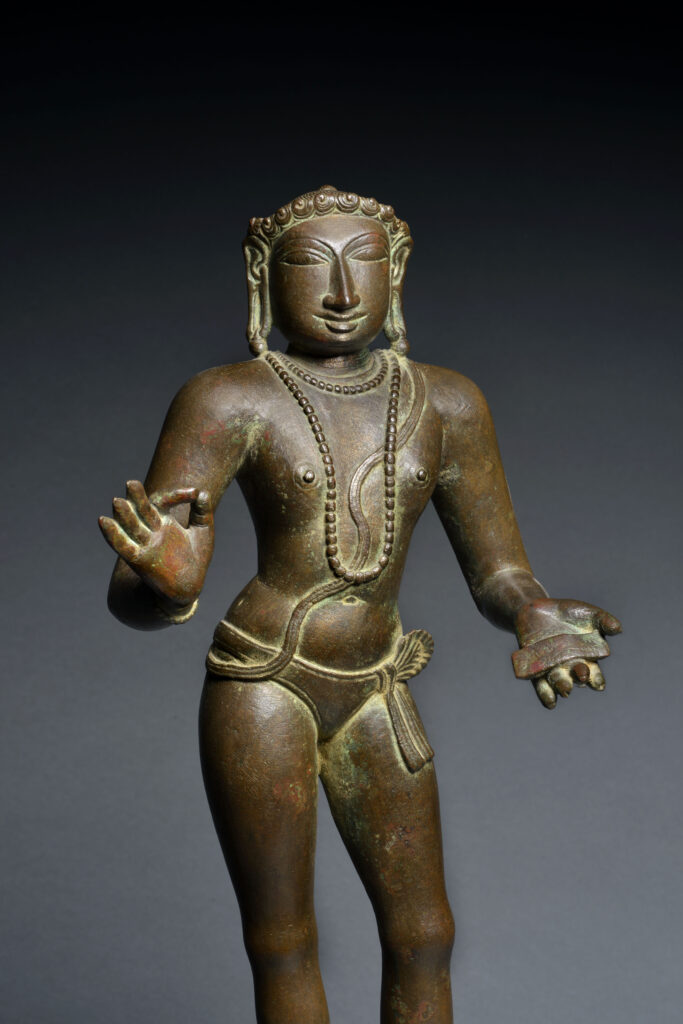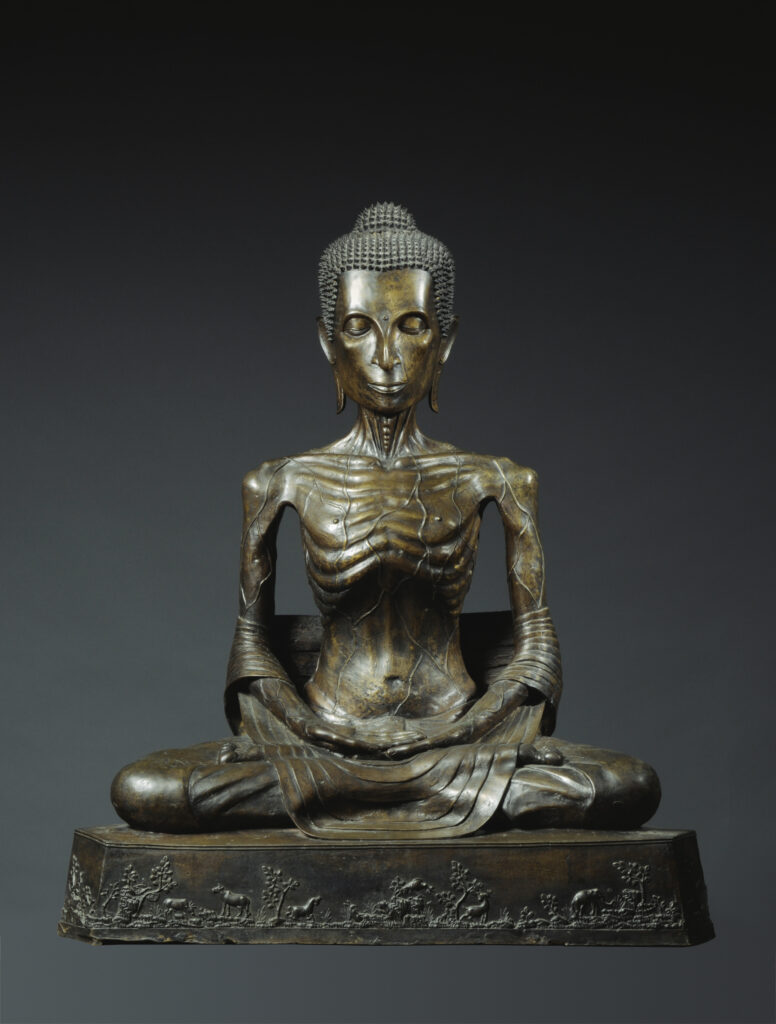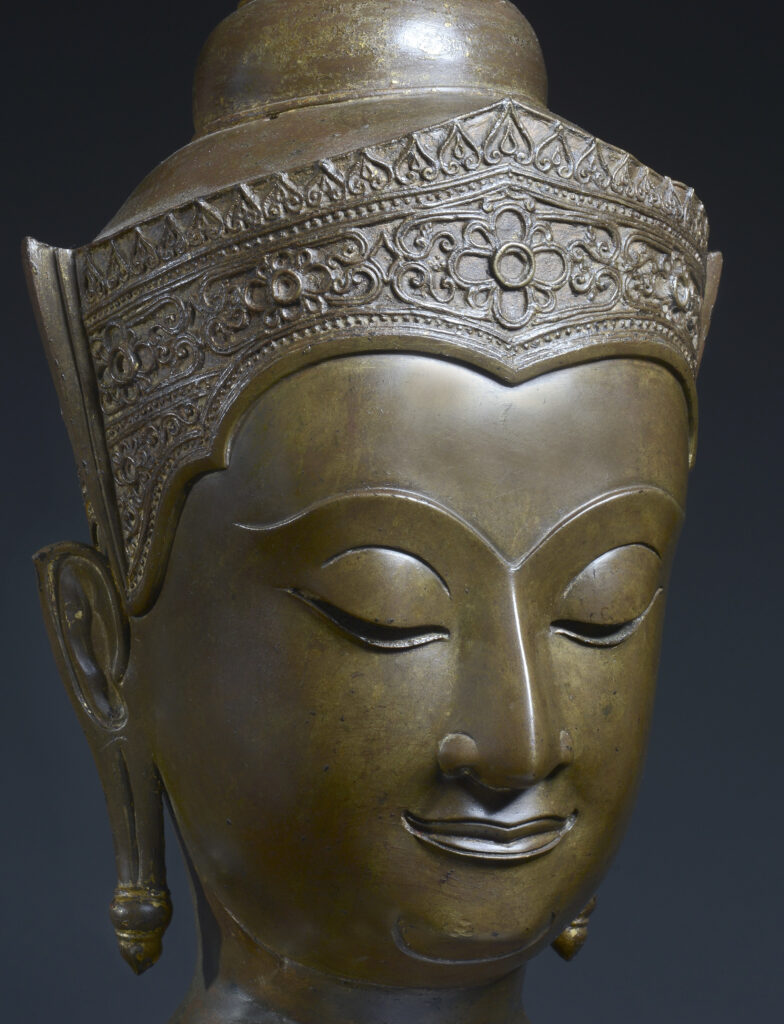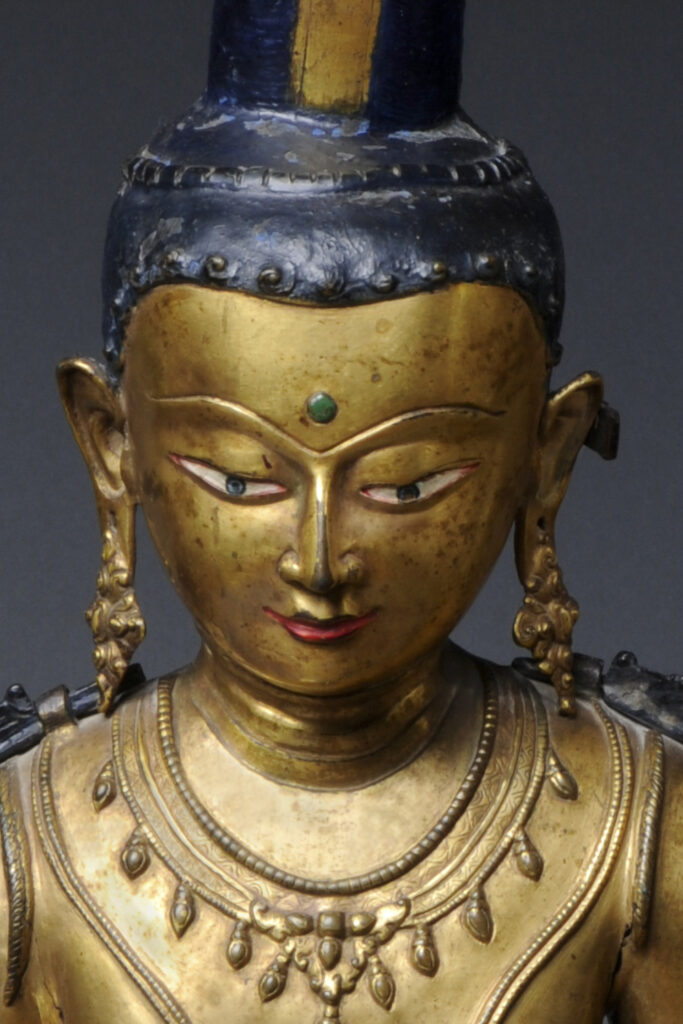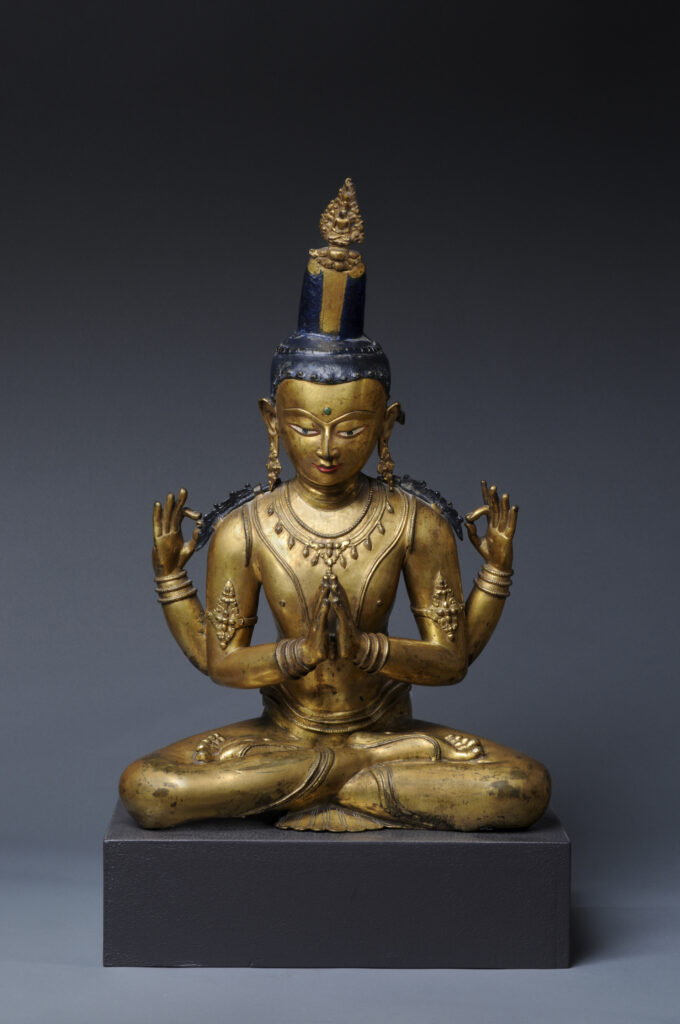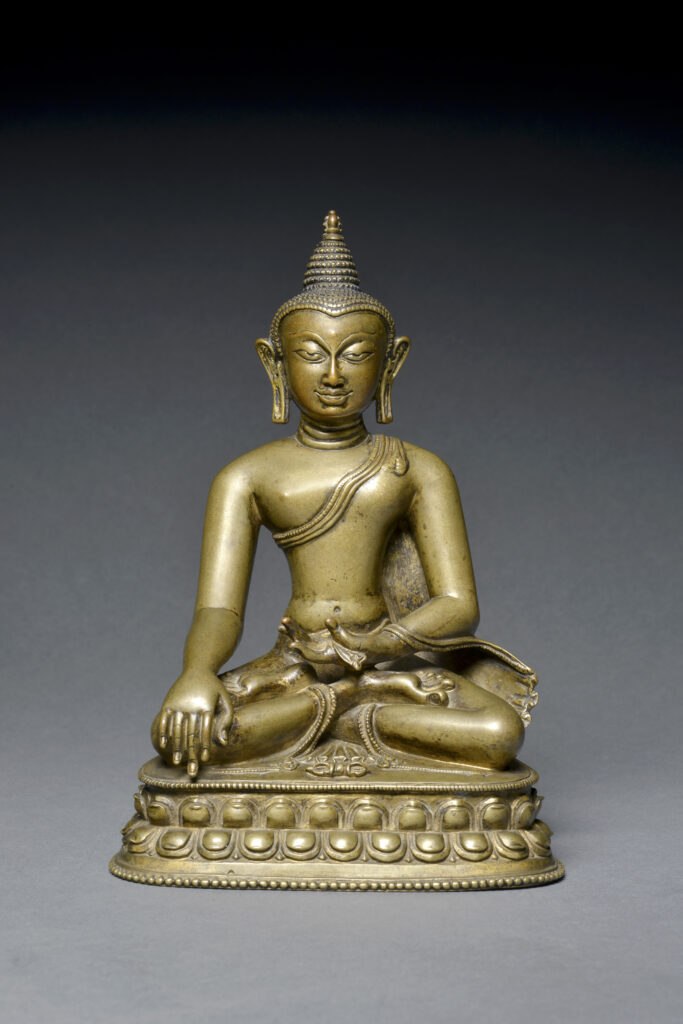Splendour of Asian Sculpture
This fine casting of the historical Buddha Sakyamuni reveals the renowned technical skill and artistic refinement of Sukhothai masters, showing well-balanced proportions, pure lines and a radiating energy. The Sukhothai kingdom, covering most of present-day Thailand, was established in the 13th century and ruled until the beginning of the 15th. Few works of art remain of this glorious period and only six dated images of the Sukhothai style are known to this day. Classic Sukhothai characteristics are evident in the large curls, pronounced ears, the lines of the eyebrows flowing into the fine bridge of Buddha’s nose, a shawl draped over the left shoulder, elegant hands with fingers of different lengths, and a smooth polished surface.
Sold to the Metropolitan Museum, New York
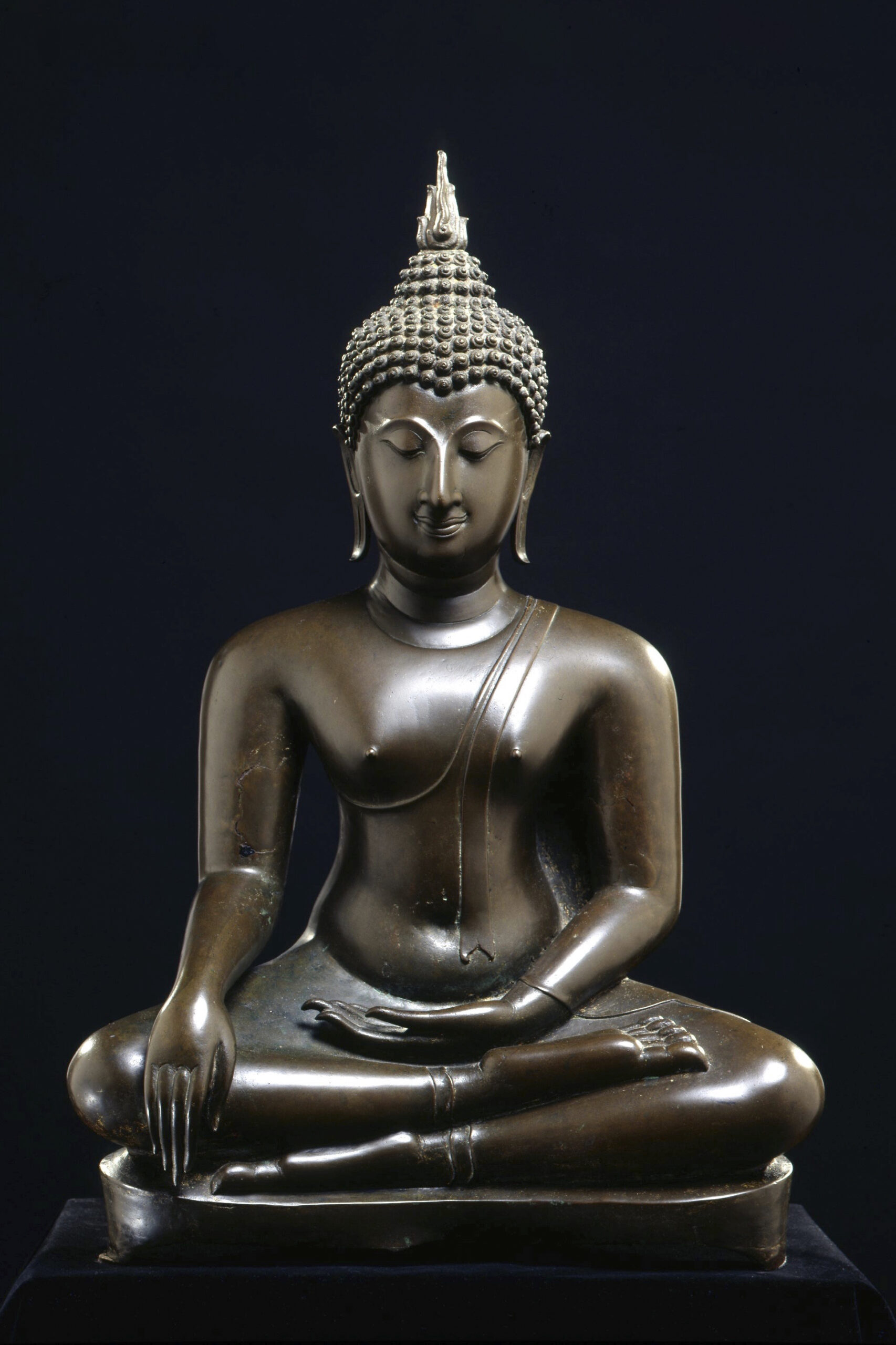
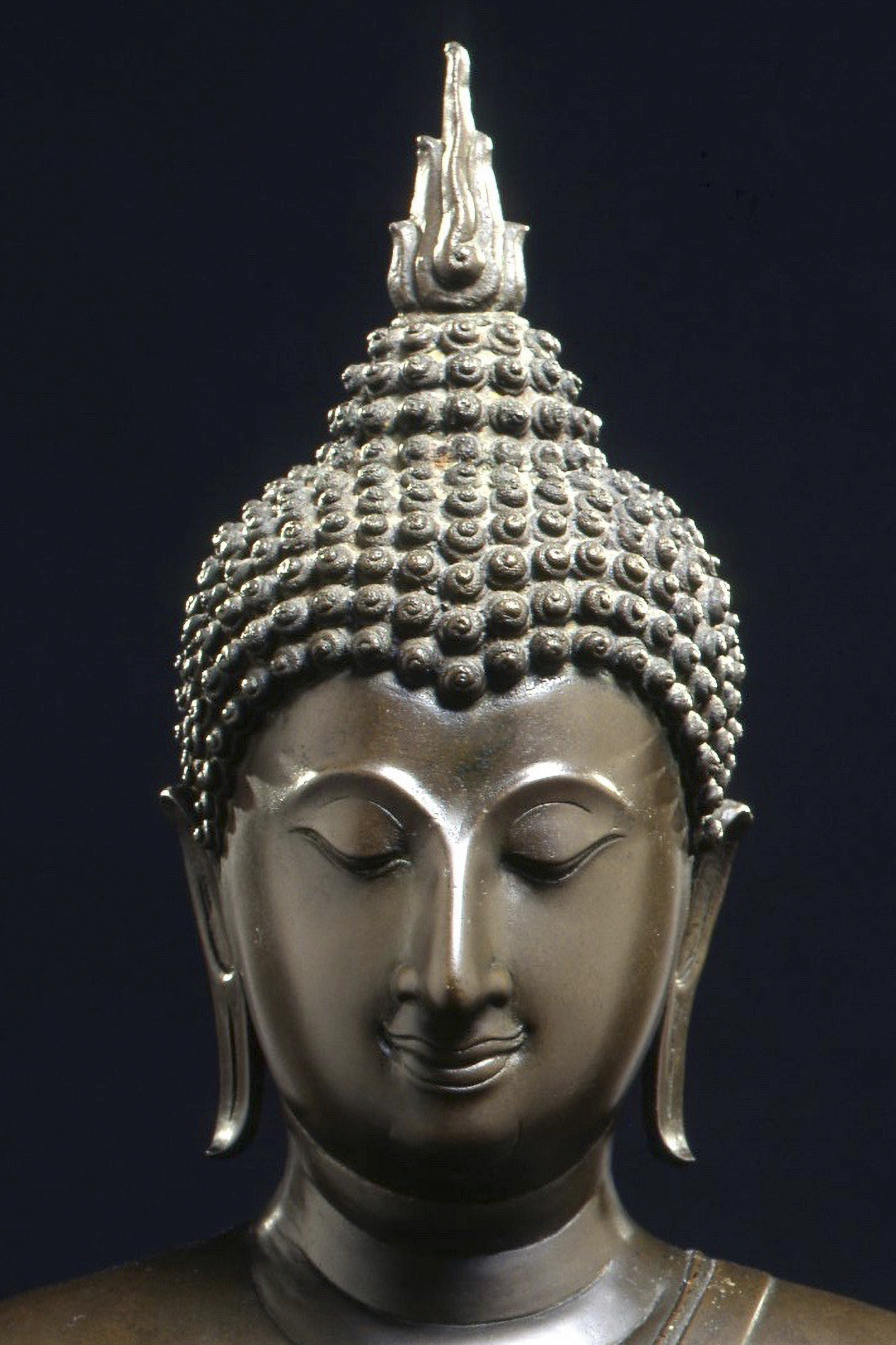
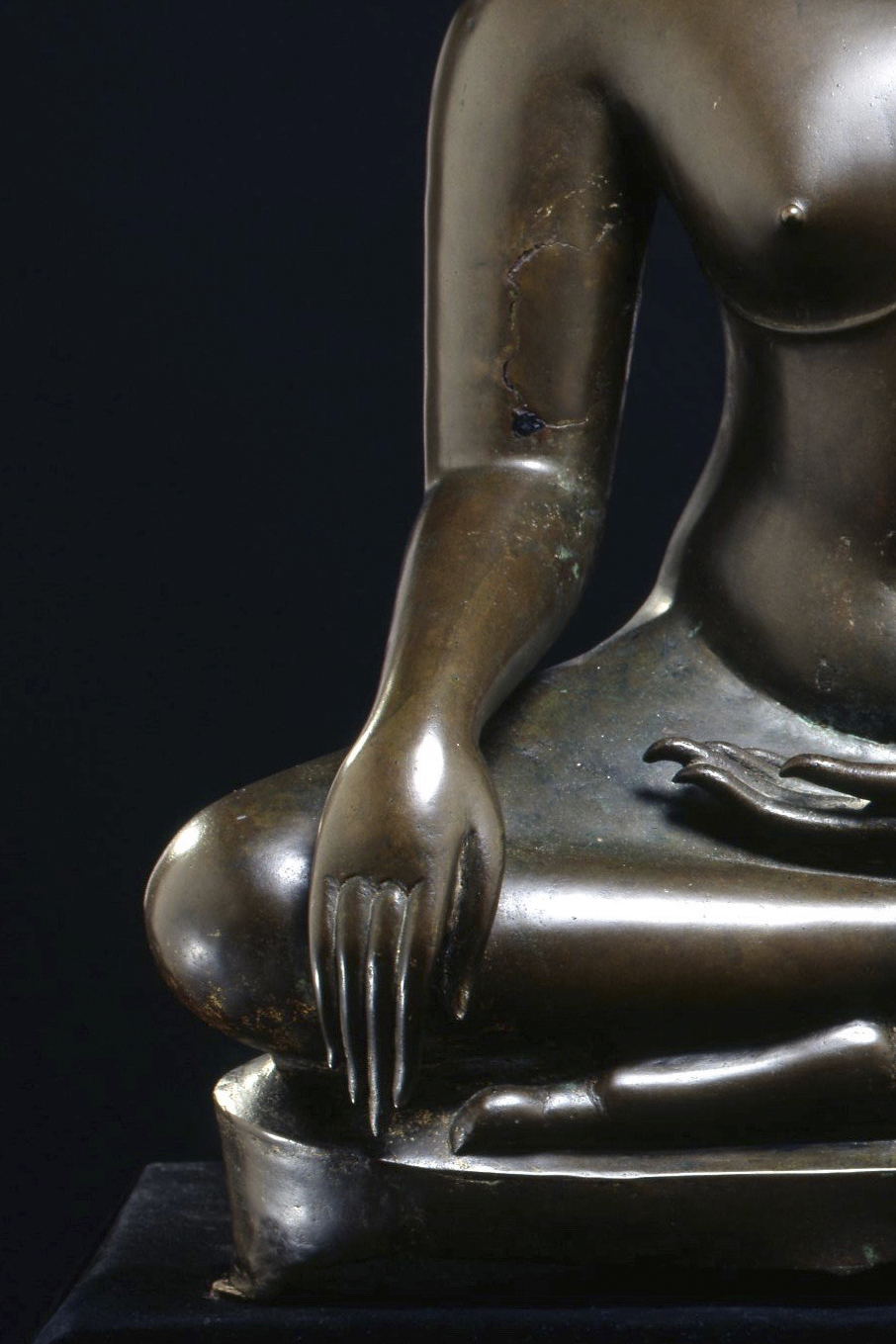
The Chola Empire (ca.850-1250) was a period of economic and political prosper that brought major architectural projects, artistic refinement, and innovation. In this setting, the present graceful Parvati was cast in bronze. Parvati is the consort of Shiva and the chief female deity in the Hindu pantheon. This sculpture is a superb example of early Chola art and portrays the deity with an incomparable artistic sophistication. The finely modelled embellishments, well-balanced proportions, and lively pose (rajalilsana) add to powerful impression of this exceptional sculpture. The bronze was selected for the cover of the important publication of Cast for Eternity: Bronze Masterworks from India and the Himalayas in Belgian and Dutch Collections (J. Van Alphen et al, 2005).
Sold to a private collection, Belgium
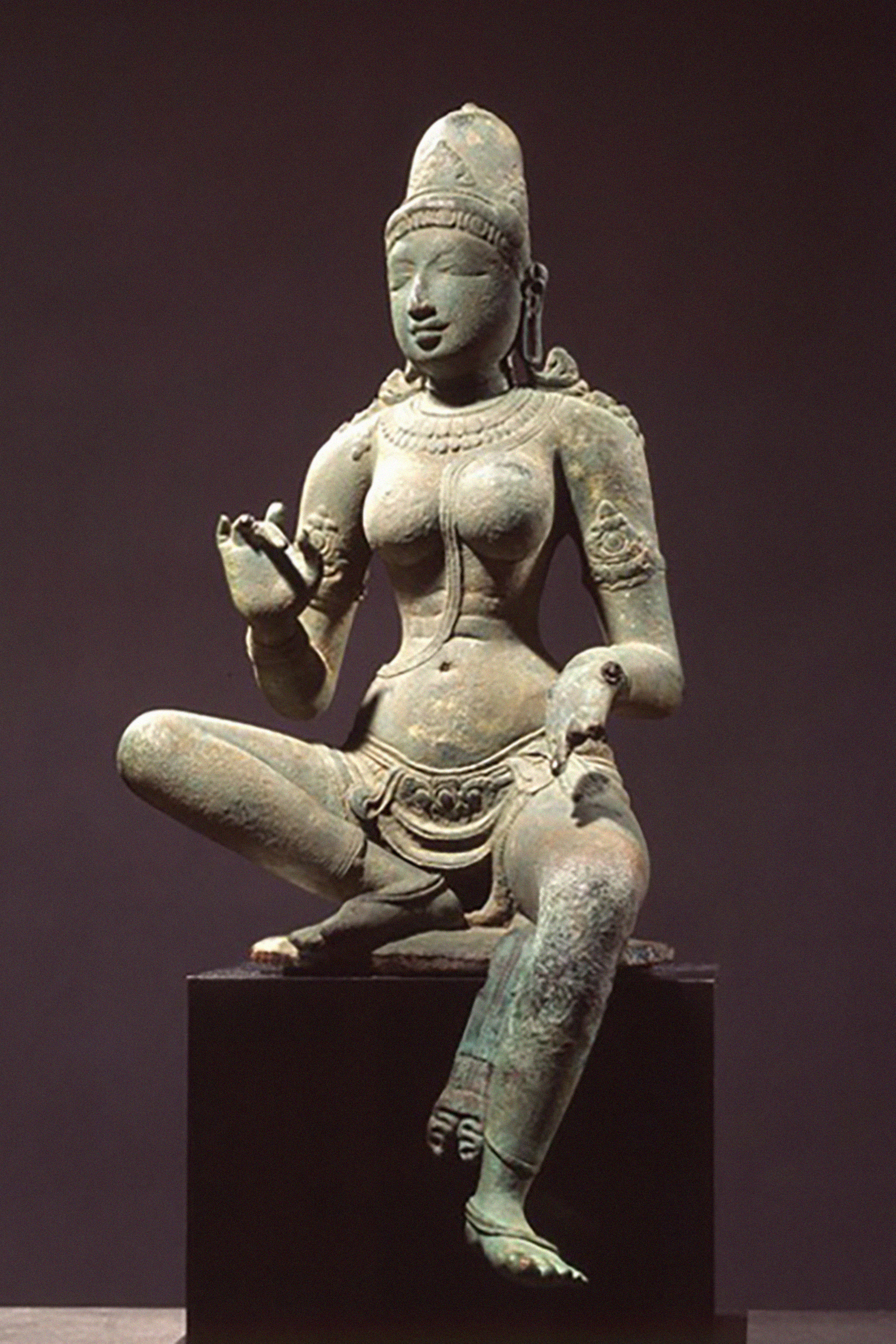
This impressive figure of a Samurai resembles portraits of the famous Kusunoki Masashige (1294-1336) who fought for Emperor Go-Daigo in the Genko war (1331-1333). He is dressed in full armour and is holding a sword - the deadliest of weapons and thus the samurai’s most treasured possession. A golden badge in the shape of a circular sun or moon is affixed to the elaborate helmet, signifying his high rank and importance. His softly sculpted face, proud posture, and majestic garments all contribute to the monumentality of this important sculpture.
Sold to the The Ann and Gabriel Barbier-Mueller Museum, Dallas
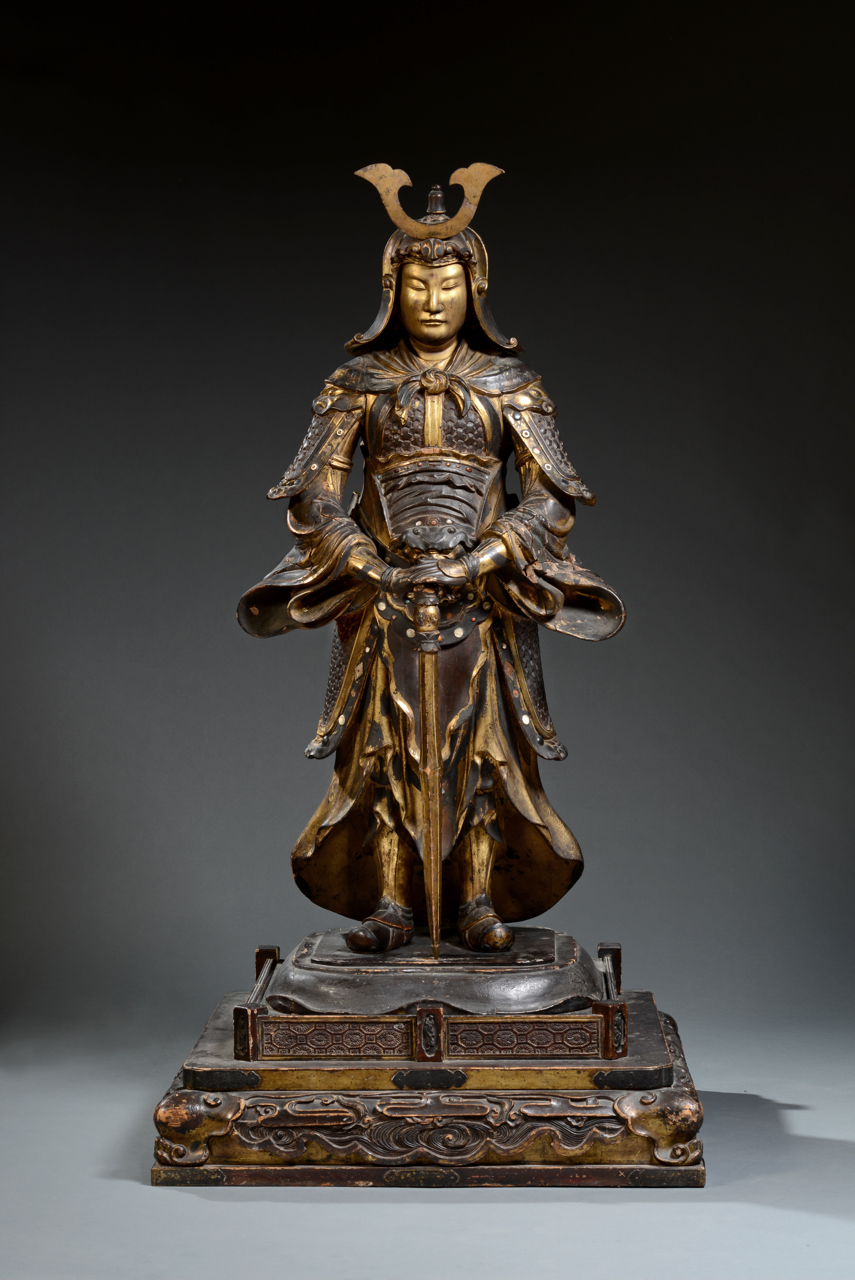
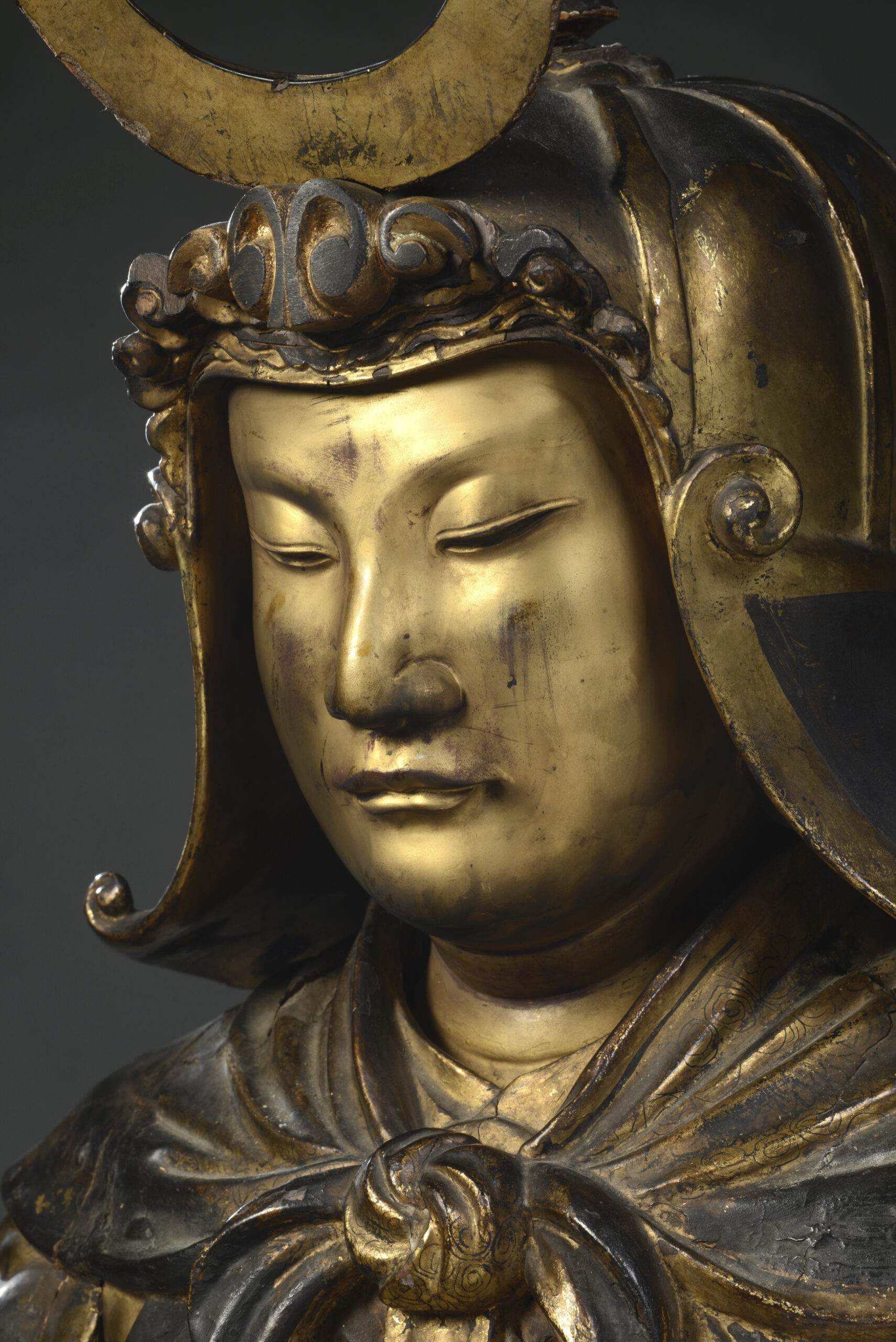
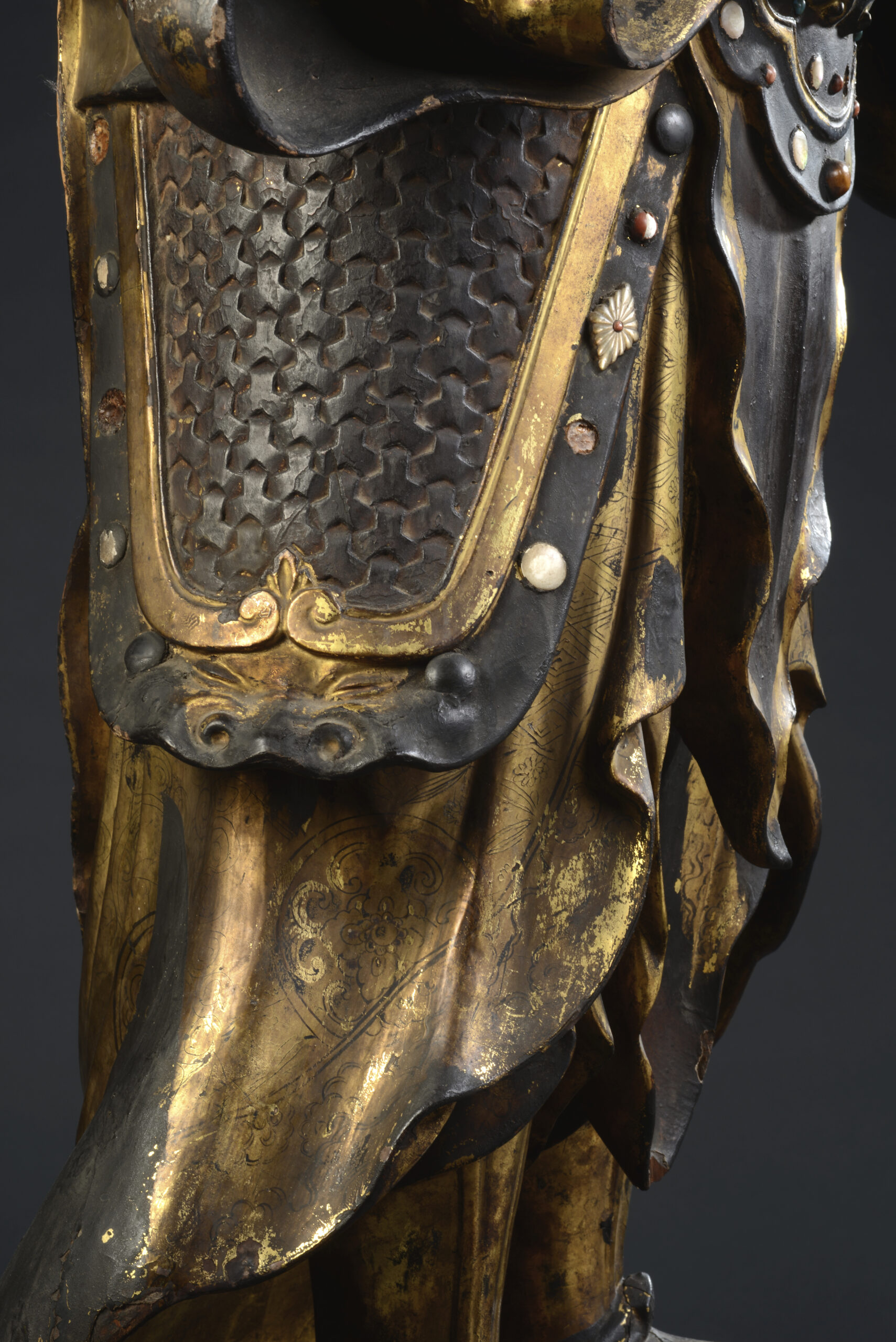
The Sailendra dynasty emerged in the 8th century in Java, Indonesia, and expanded their rule to the Srivijaya kingdom, Sumatra. The dynasty was a strong advocate for Mahayana Buddhism and was known for their great cultural, architectural, and artistic accomplishments. Avalokitèshvara, the boddhisattva of compassion, is standing upright with twelve arms fanning out, generating a powerful rhythm to the composition. This impressive statue is one of the few bronzes of this size to survive from the Srivijaya kingdom and remains an important early Mahayana Buddhist sculpture.
Sold to a private collection, USA
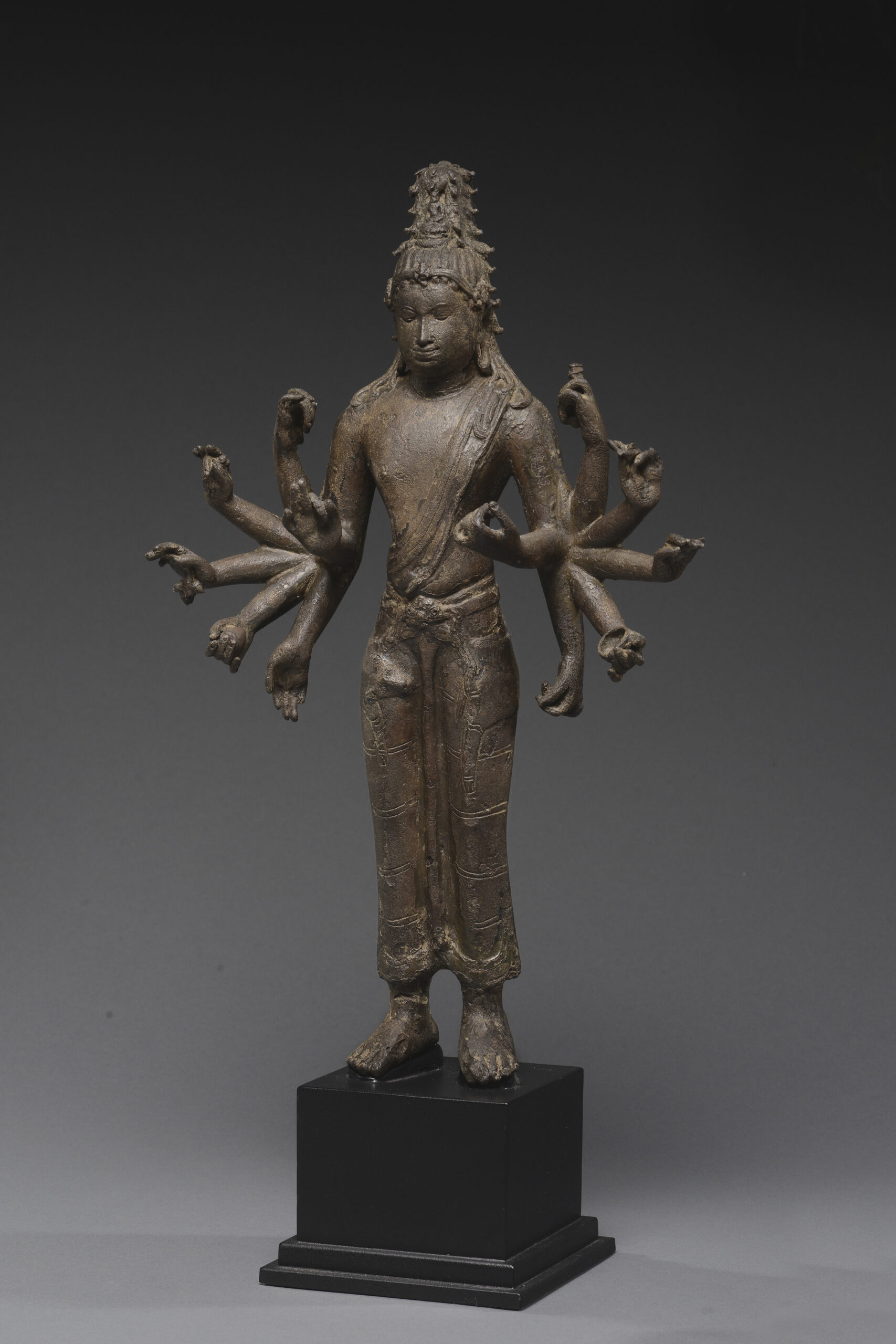
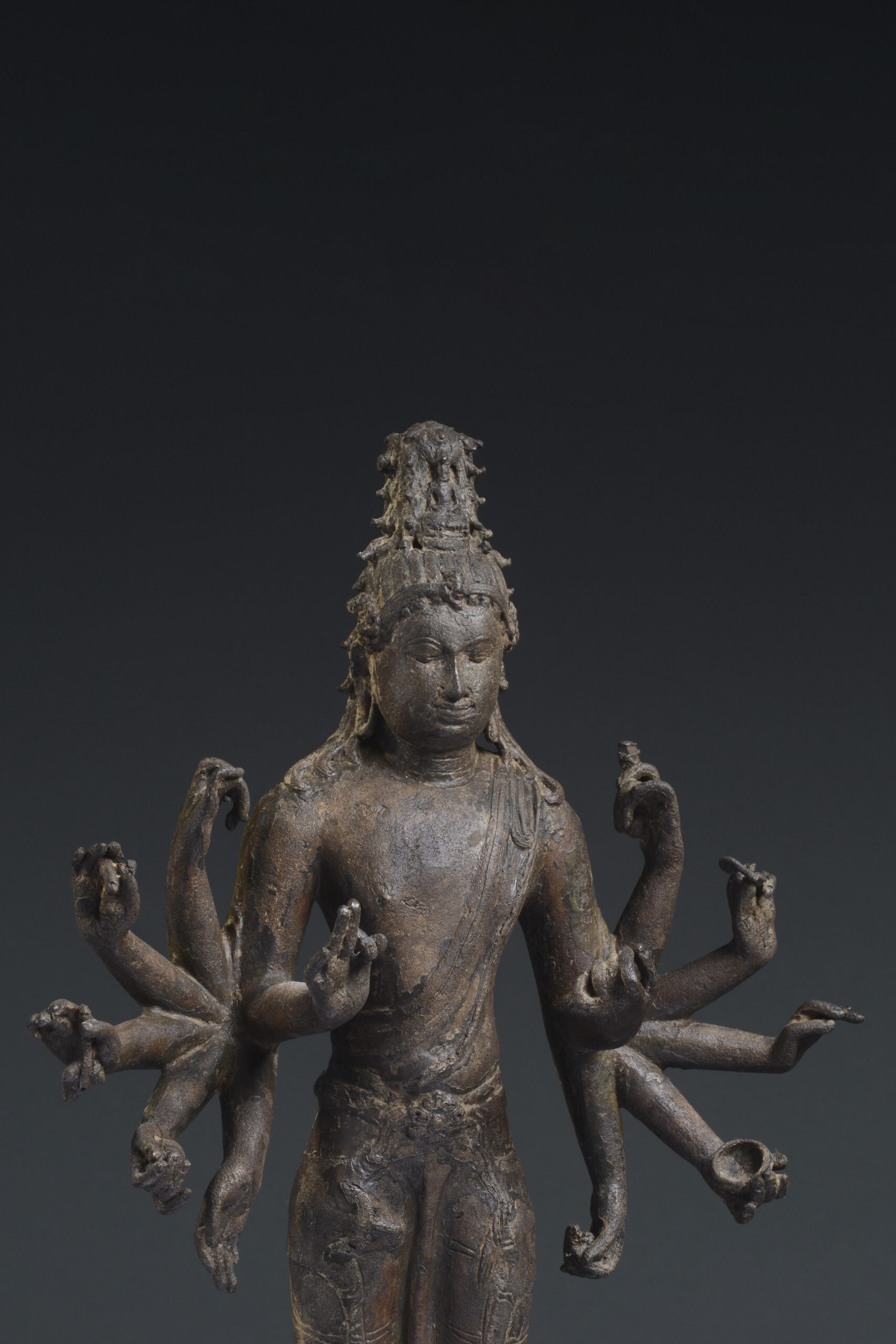
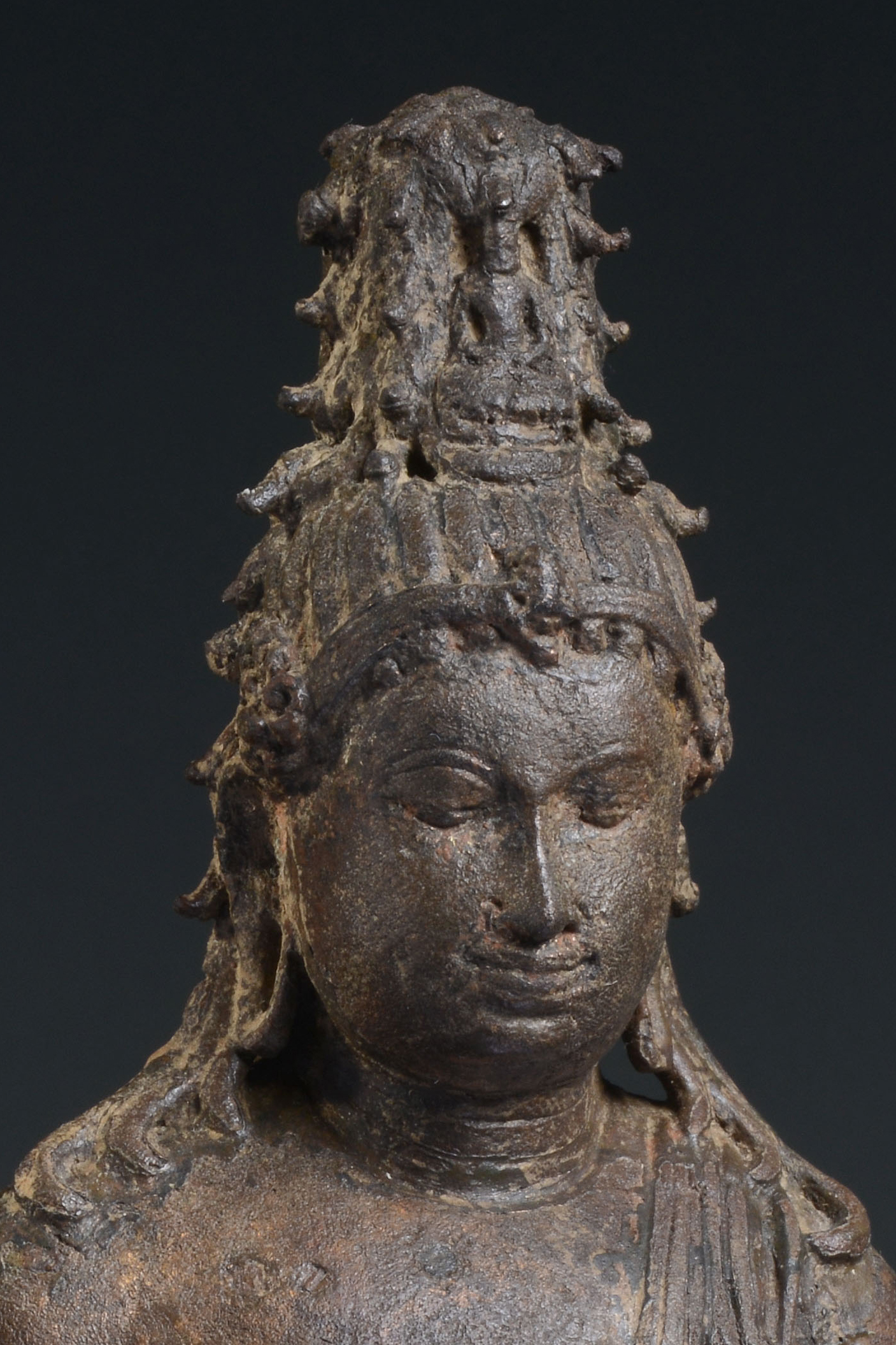

This extraordinary portrait of the historical Buddha Gautama Sakyamuni shows a particular moment in his path to enlightenment: when he consumed a singly grain of rice a day to purify his body and distance his mind from earthly matters. Depictions of the emaciated Buddha were particularly popular between the 2nd and 4th century and few later examples remain. This impressive bronze is in excellent condition and reveals fine details, including the tight curls covering his head, the fine pleats of his garment, and the pronounced veins on his torso and arms. This sculpture has a notable provenance, as it was commissioned by the former King of Thailand, King Chulalongkorn or King Rama V.
Sold to the Ger Eenens Collection, The Netherlands. Now on display in the Victoria & Albert Museum, London (no. 1-2019, Buddhism, Room 471, The Robert H.N. Ho Family Foundation Galleries of Buddhism Art, case 10)

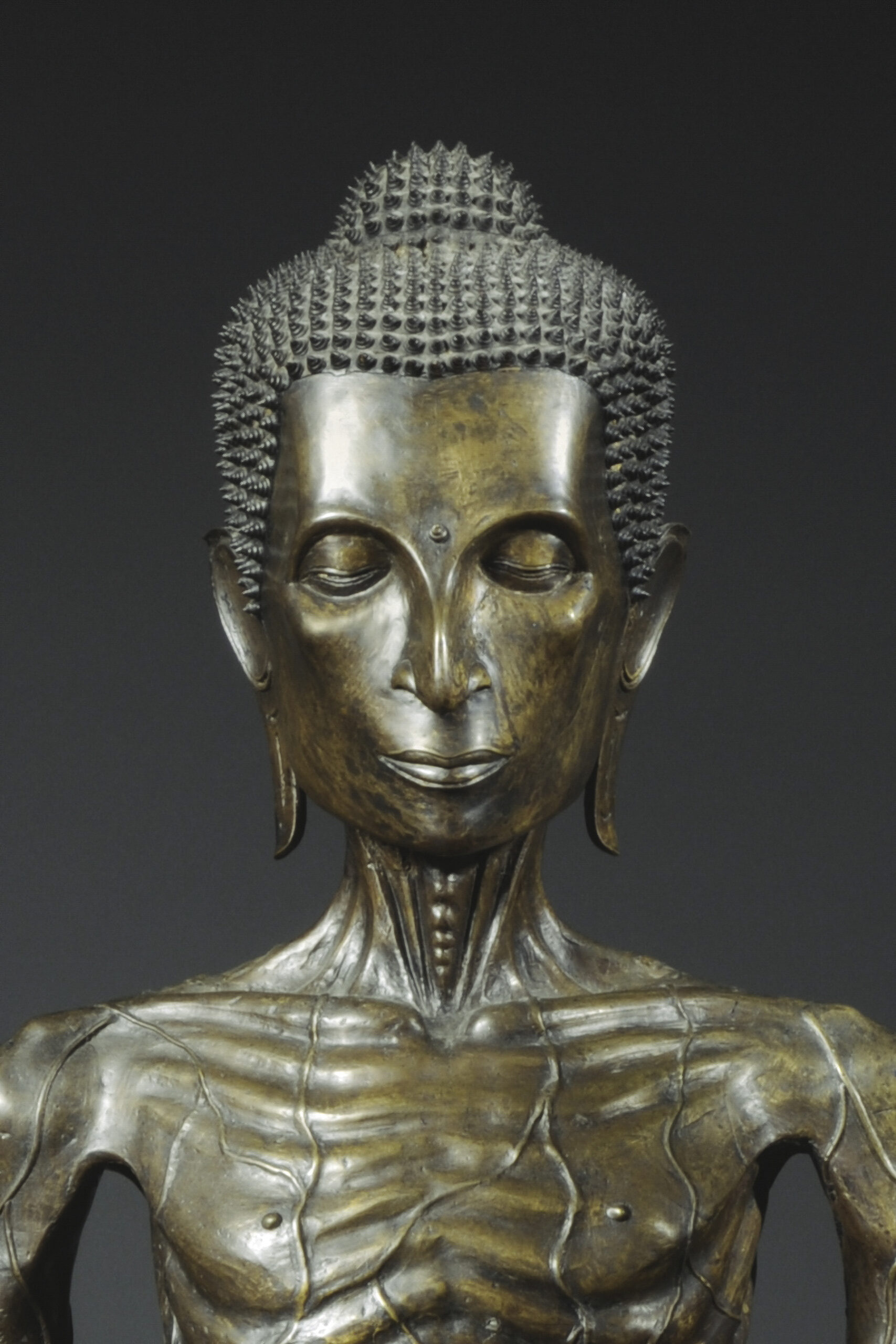

Manikkavacakar is a saint, who lived in the 9th century in south India. He is celebrated for his famous poem book Tiruvasakam and other religious texts. The saint is portrayed in an elegant standing pose and holds a folio of a manuscript in his proper left hand, which refers to his divine wisdom. The beautiful natural patina was created by ritual cleansings in devotional practise. The Chola period was known for its continuous artistic refinement and innovation. The present graceful figure shows meticulous casting of every detail and demonstrates a highpoint of Chola workmanship.
Sold to a private collection, Australia
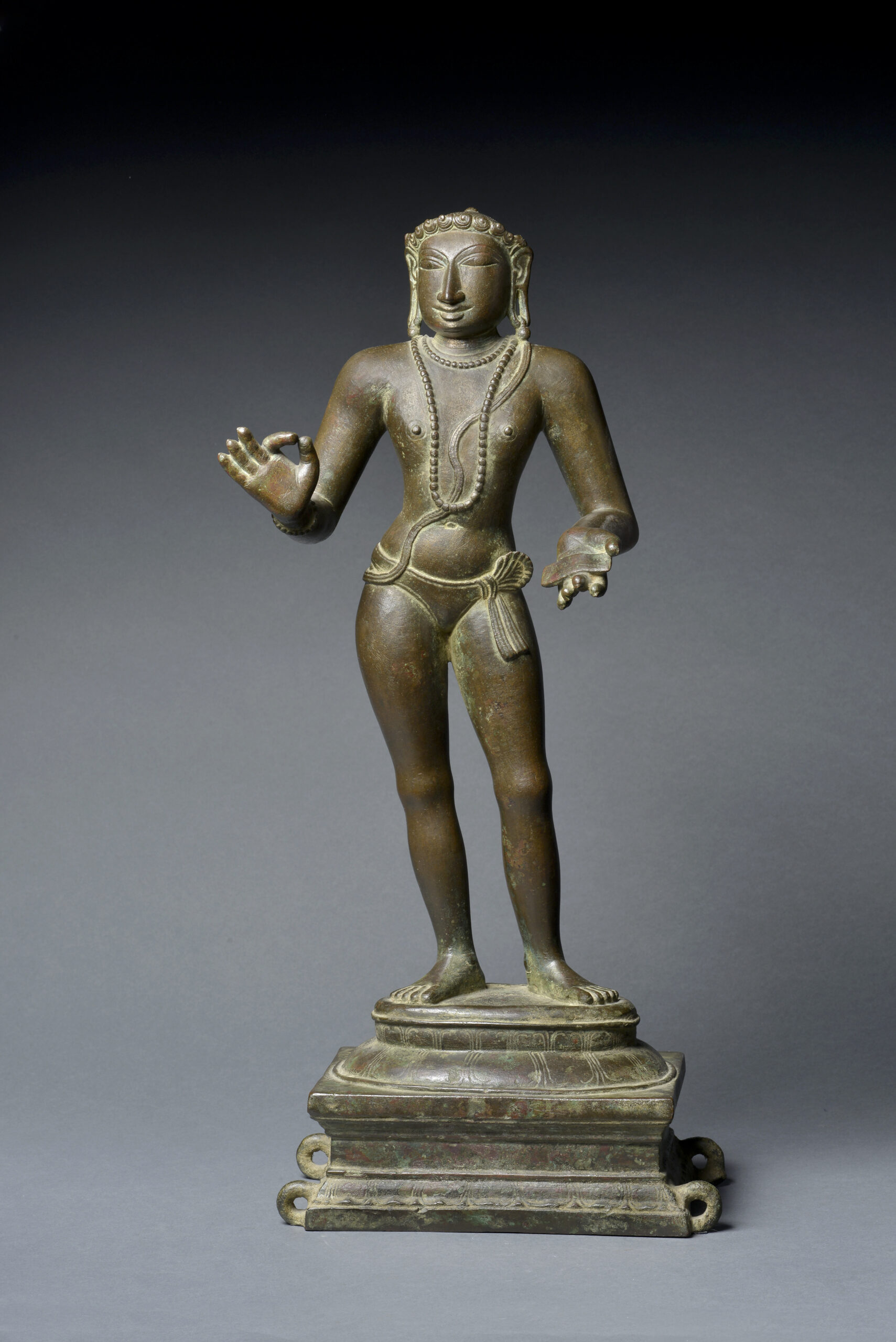
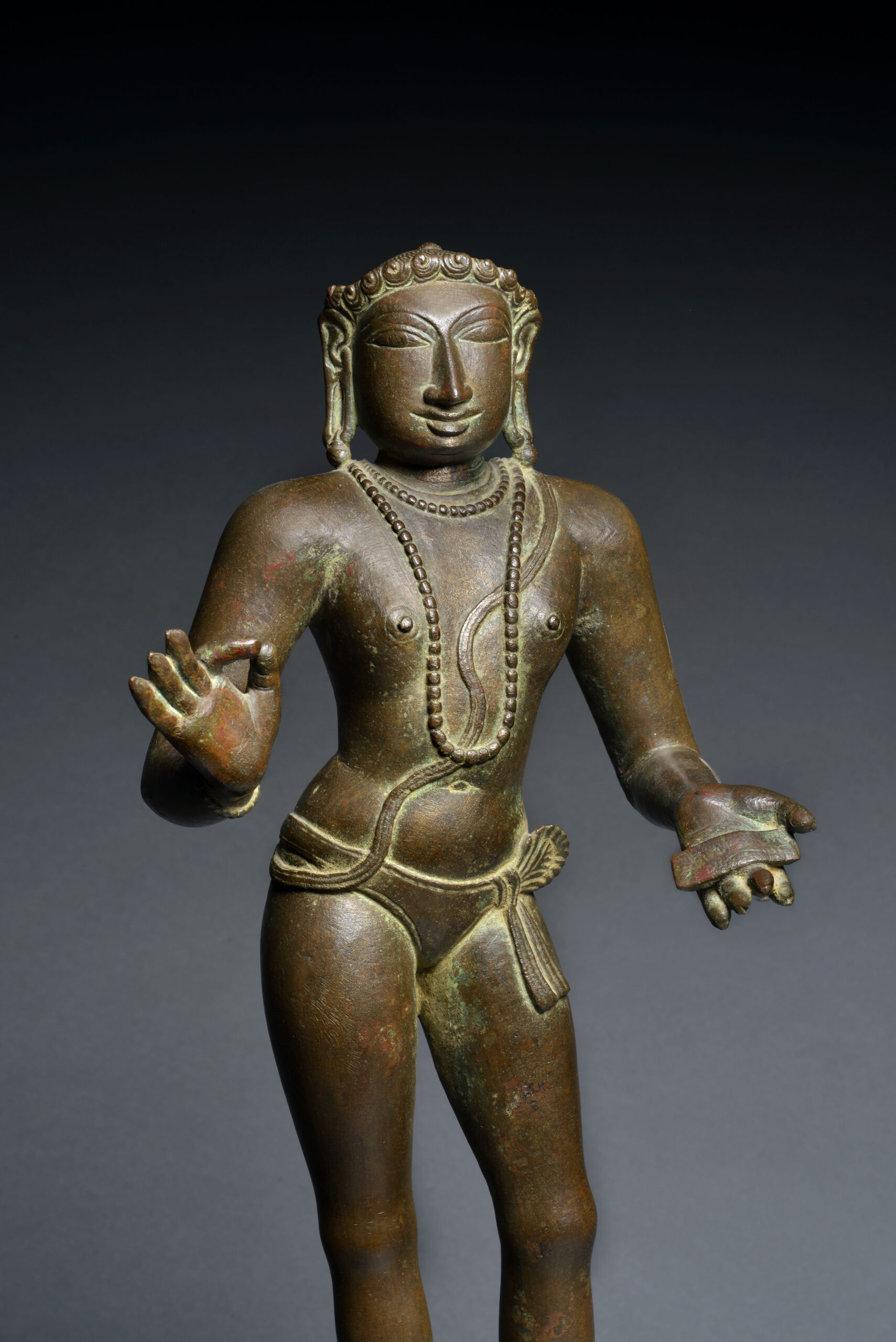
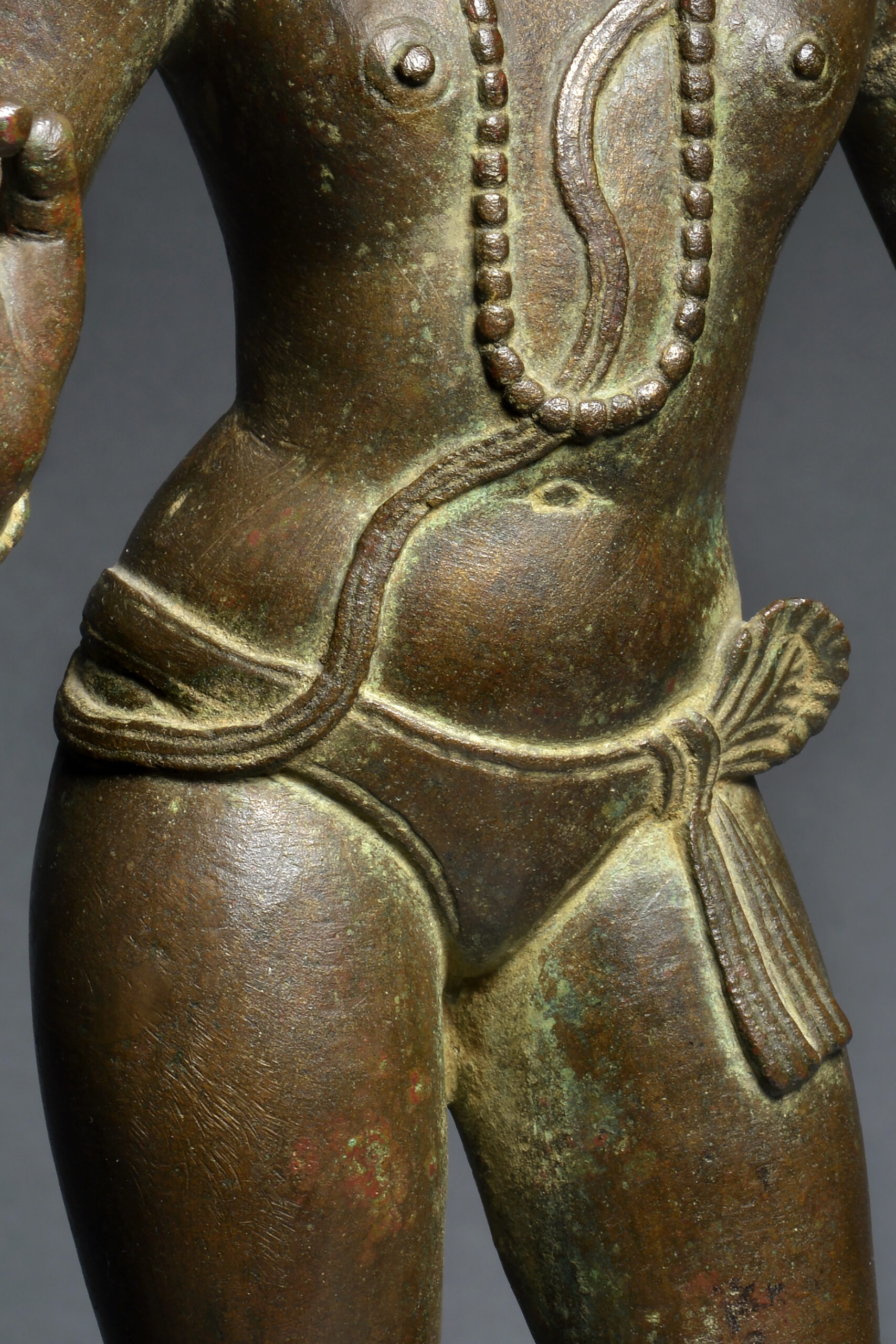
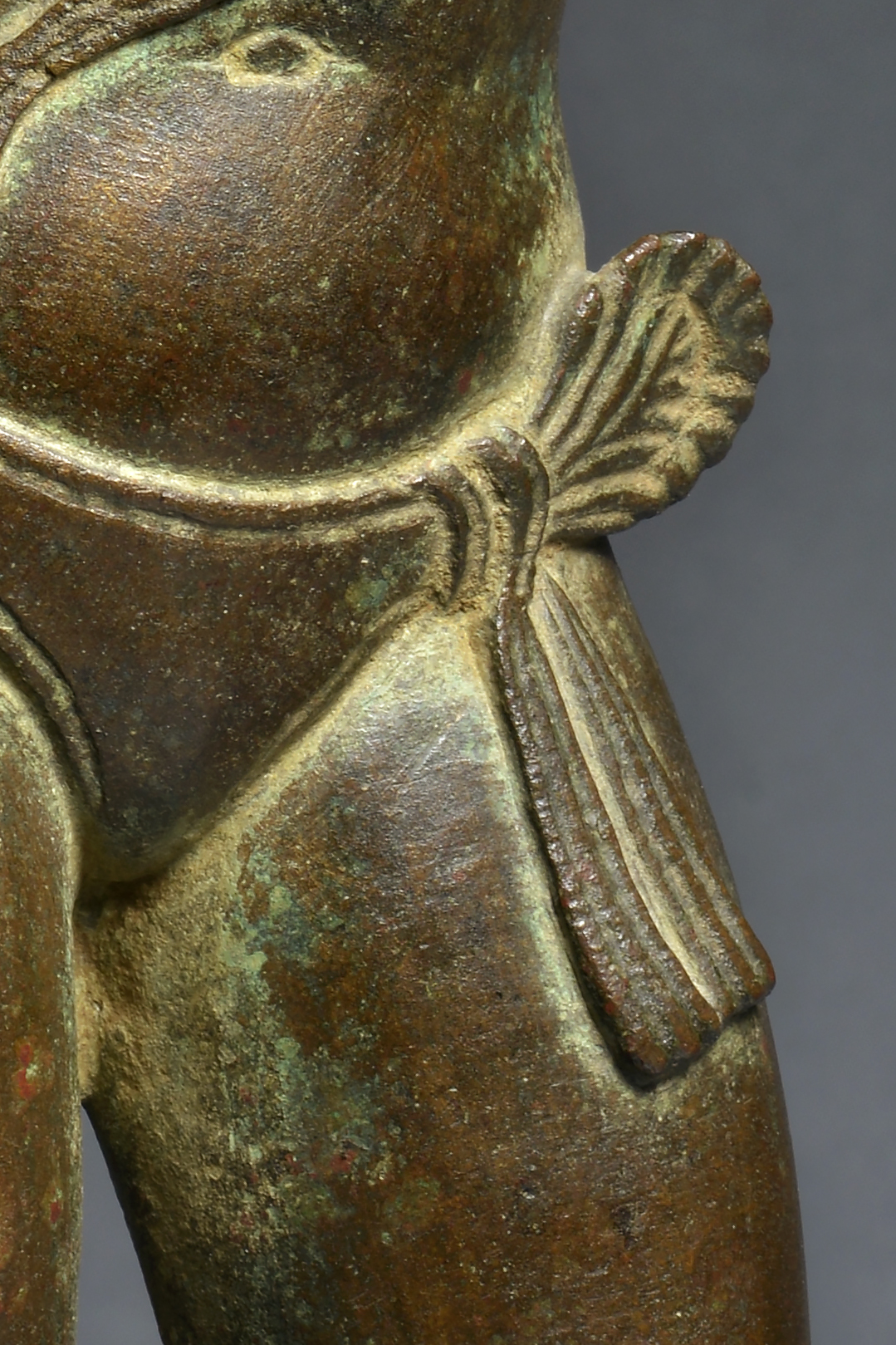
The figure depicted in the centre of the fine Buddhist shrine is the historical Buddha Gautama Sakyamuni. The present bronze is strongly influenced by Cambodian sculpture of the 12th and 13th centuries and shows a high level of sophistication that that stands out within the corpus of Lopburi bronzes. The exquisite quality of the casting, crisp detail, impressive size, and perfectly balanced proportions, show that the present sculpture is a rare masterpiece of Khmer art.
Sold to the Asian Art Museum, San Francisco.
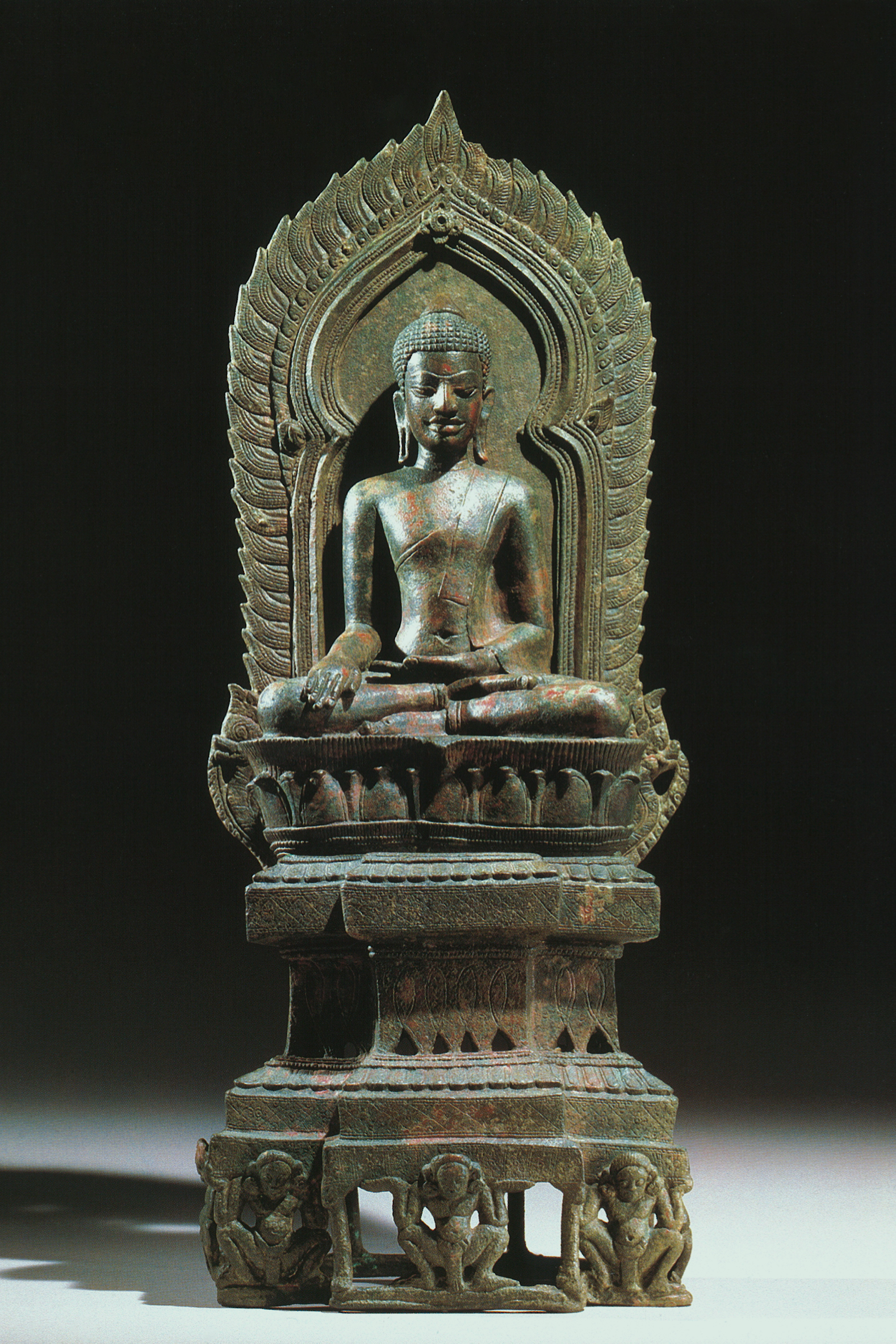
Vajrasattva was venerated as a cosmic Buddha in the cult of Ka-Dam-Pa, which was conceived by the Indian guru Artisa in the 11th century. The sculpture is adorned with fine decorations throughout, including sophisticated necklaces, bracelets, and anklets. The detailed three-leafed crown, the large circular earrings, and the engraved geometric and floral patterns on Vajrasattva’s garment are early stylistic designs consistent with 14th century Tibetan art. This exquisite cosmic Buddha is amongst the most impressive and largest sculptures of Vajrasattva in Western collections.
Sold to a private collection, Switzerland
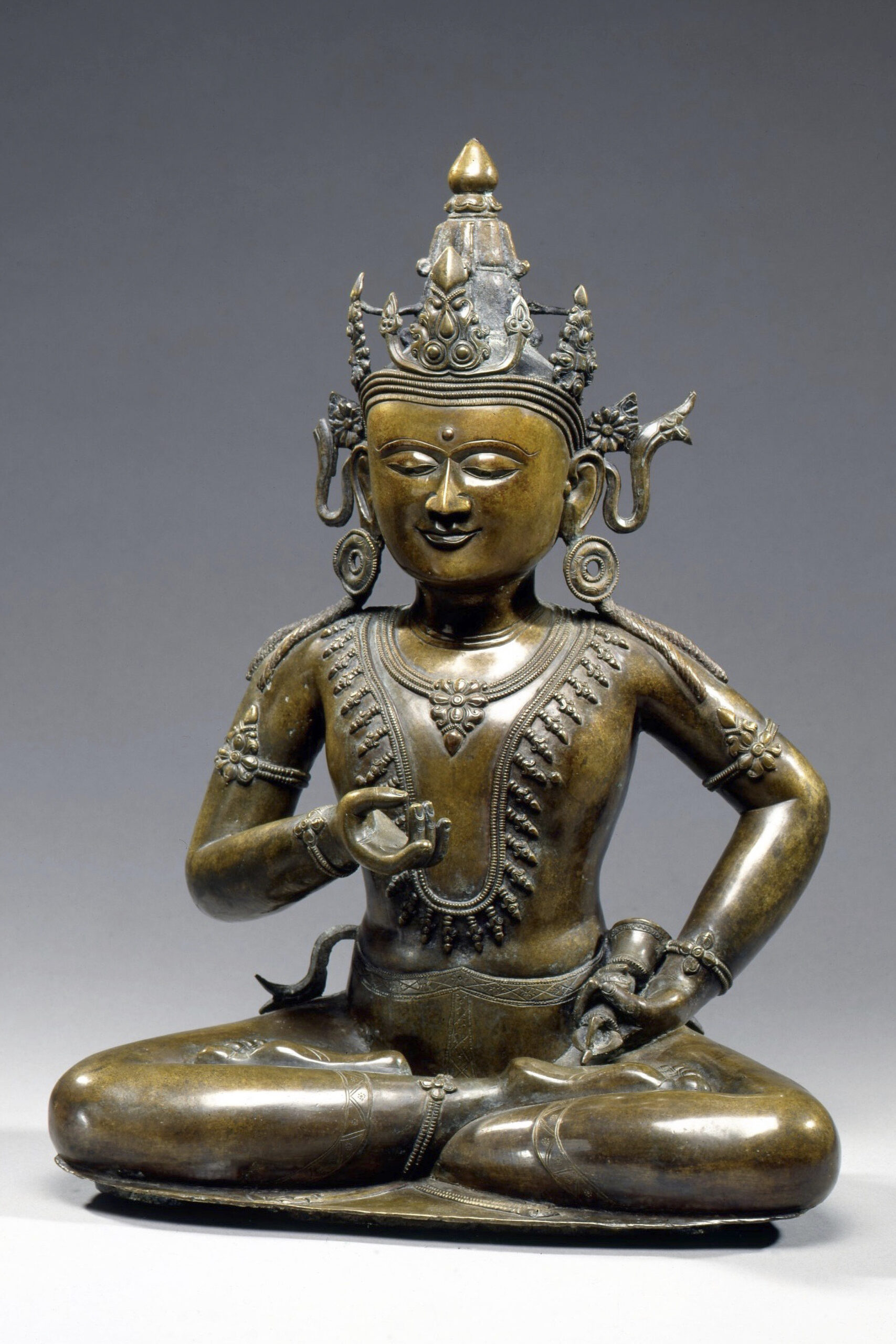
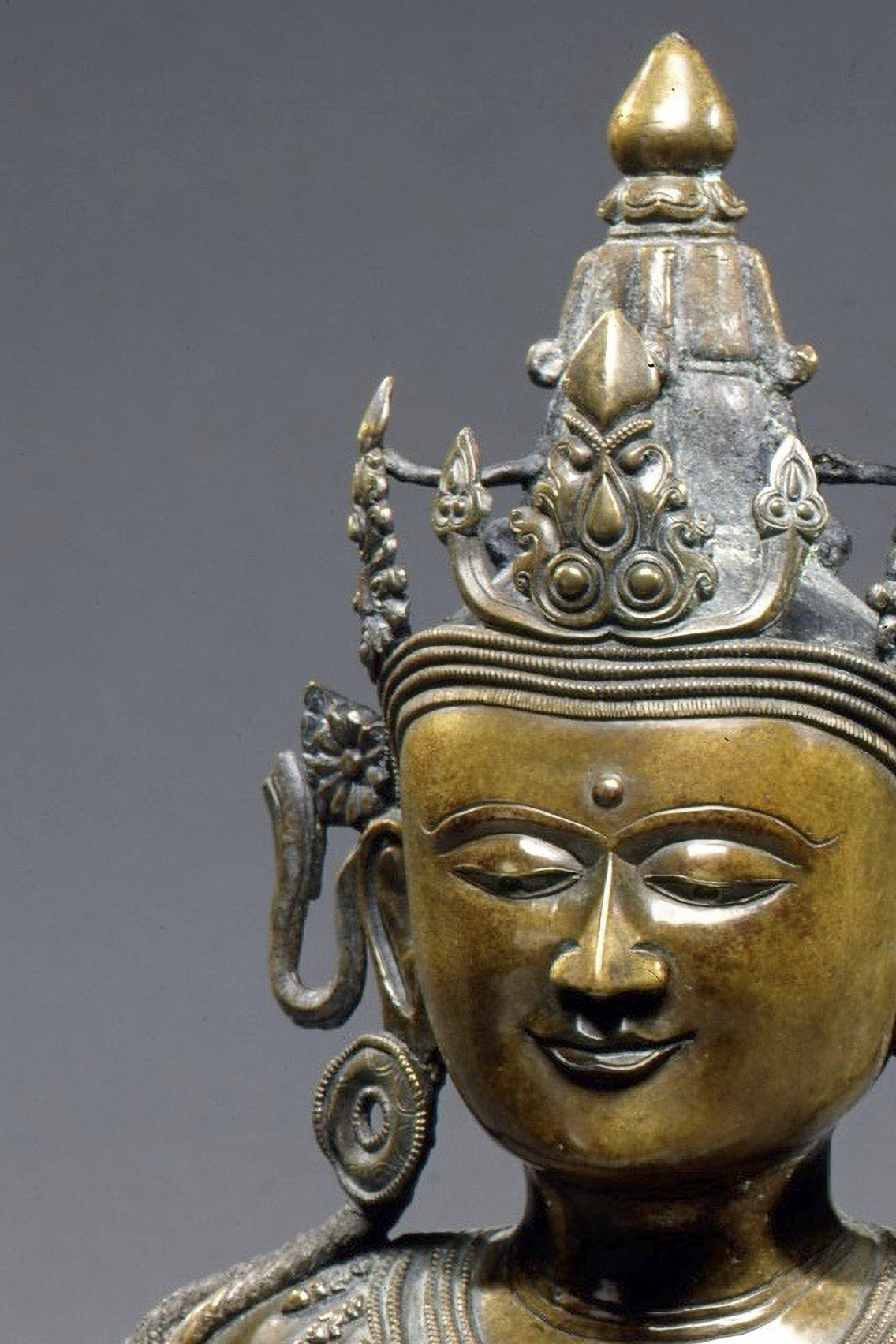
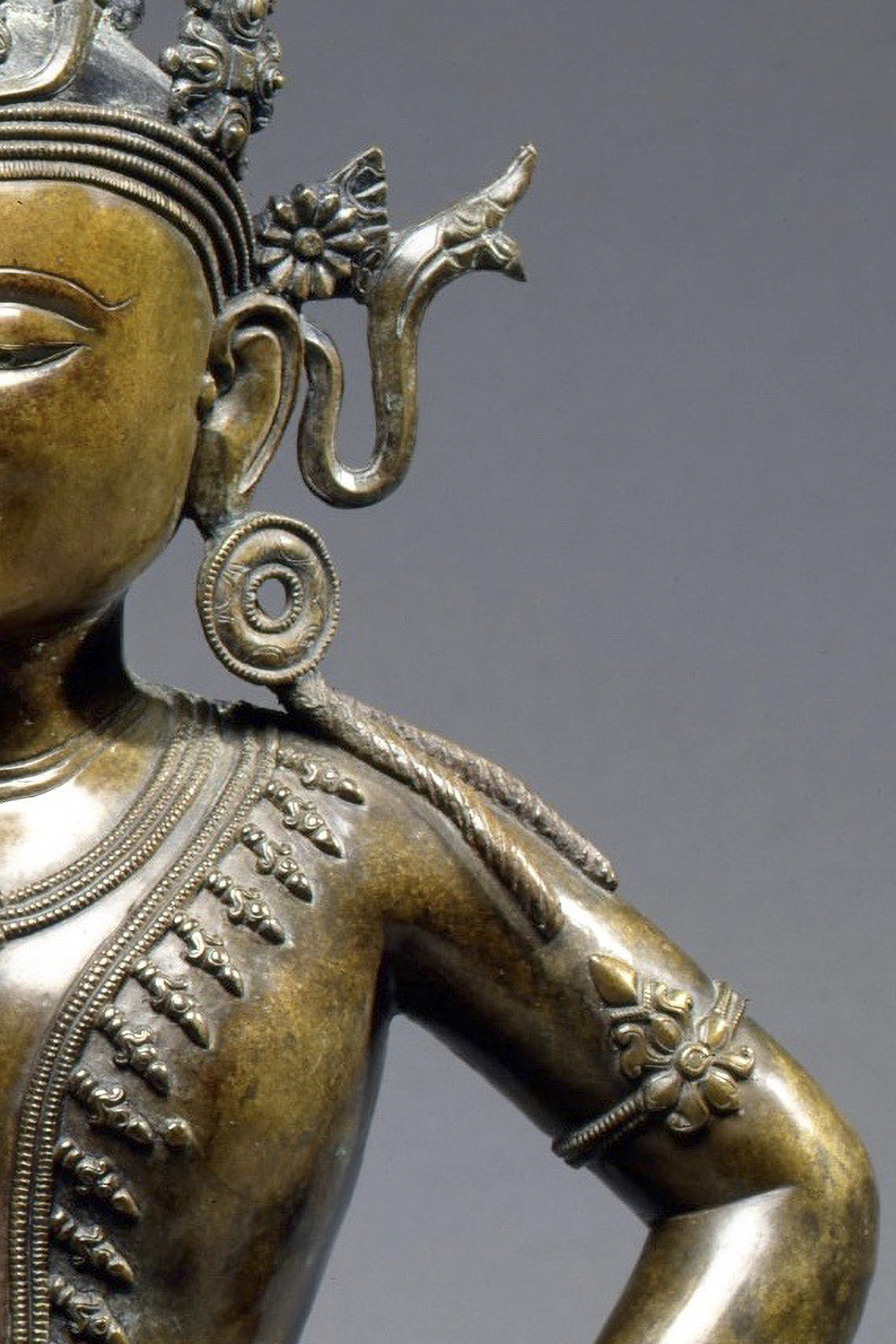
A yali is a mythological horned lion who is a personification of rampant natural forces. Such lions were often incorporated in architectural structures, including the present banisters which were presumably positioned at the entrance of a temple or palace. The two Yalis are beautifully decorated with jewellery and geometric designs, accentuating their dynamicity and powerful energy. These monumental rare sculptures are the exclusive examples in Western collections.
Sold to the Royal Ontario Museum, Toronto


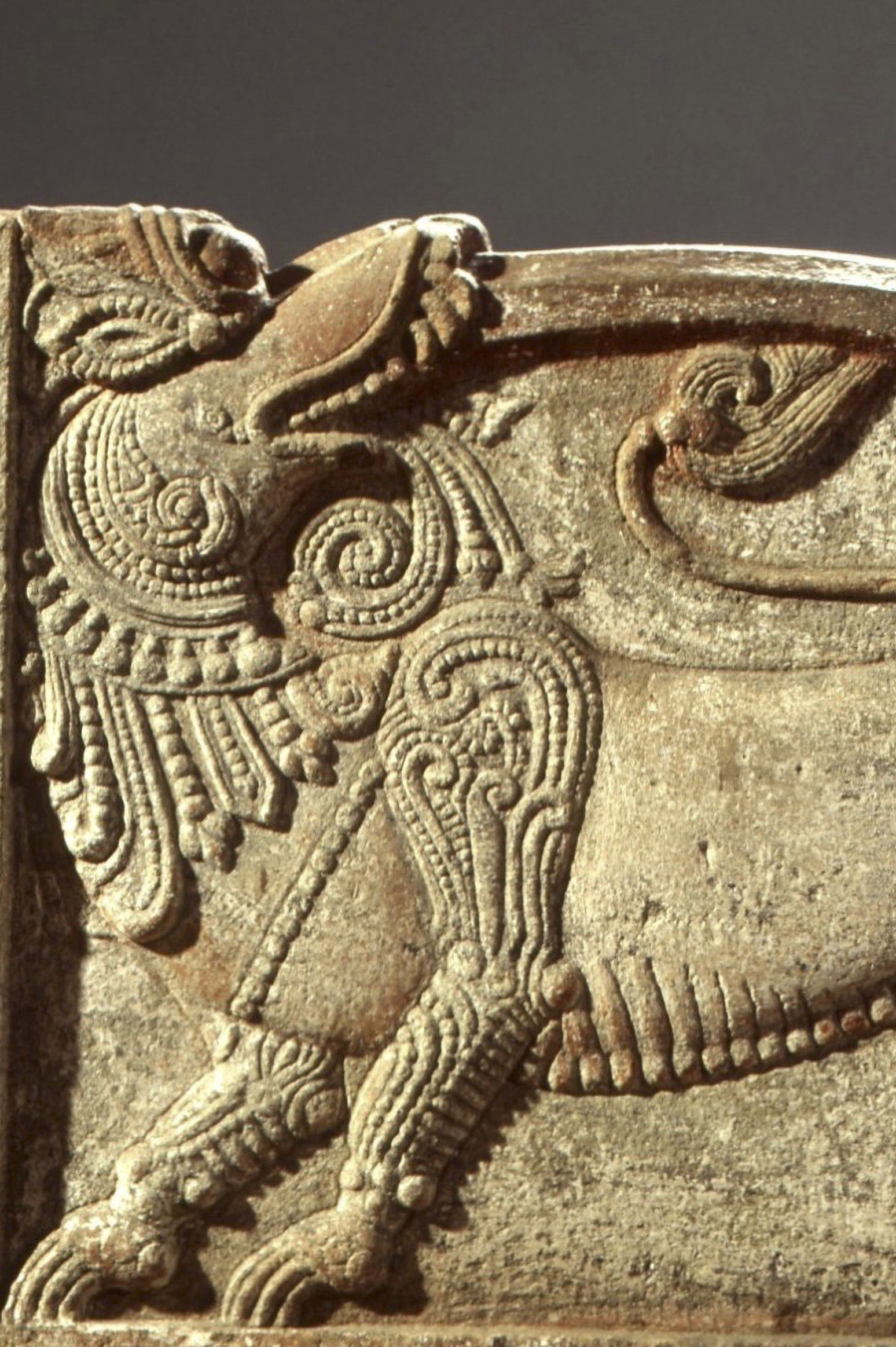
This life-sized head of the historical Buddha Gautama Sakyamuni is a classic example of Gandhara art. The Gandhara region comprised northern parts of Pakistan and southern parts of Afghanistan. Lying onto the silk route, it became an important and influential Buddhist centre, producing art strongly influenced by Greco-Roman, Iranian and central Asian traditions. Classic traits include the waving hair, the large unisha on his forehead (which presumably held a gem), and the striking realism of the features of the face. One rarely comes across a Gandhara work in such exquisite condition, revealing the high level of lifelike quality, deep spirituality, and pureness of a Buddhist sculpture.
Sold to a private collection, Germany
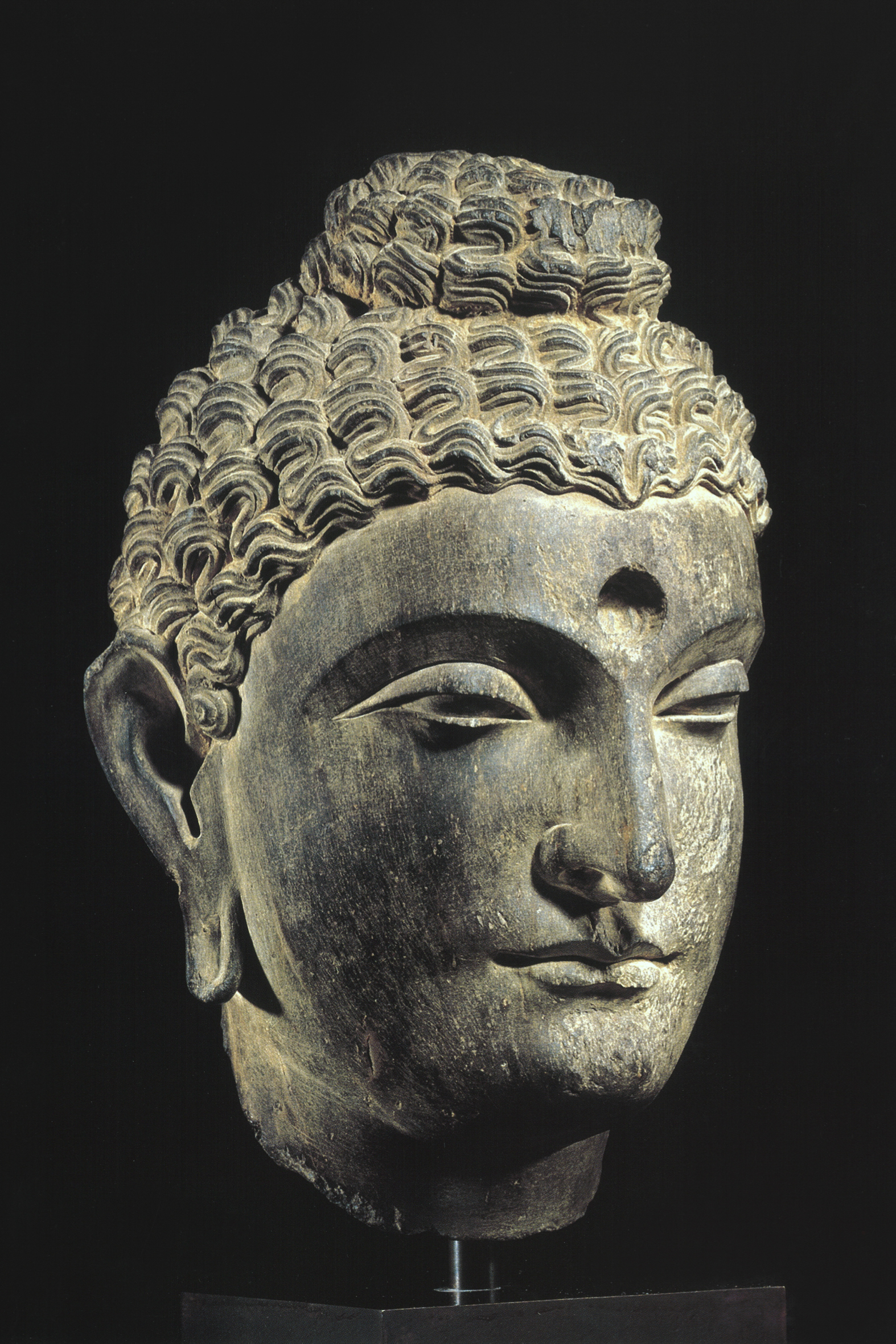
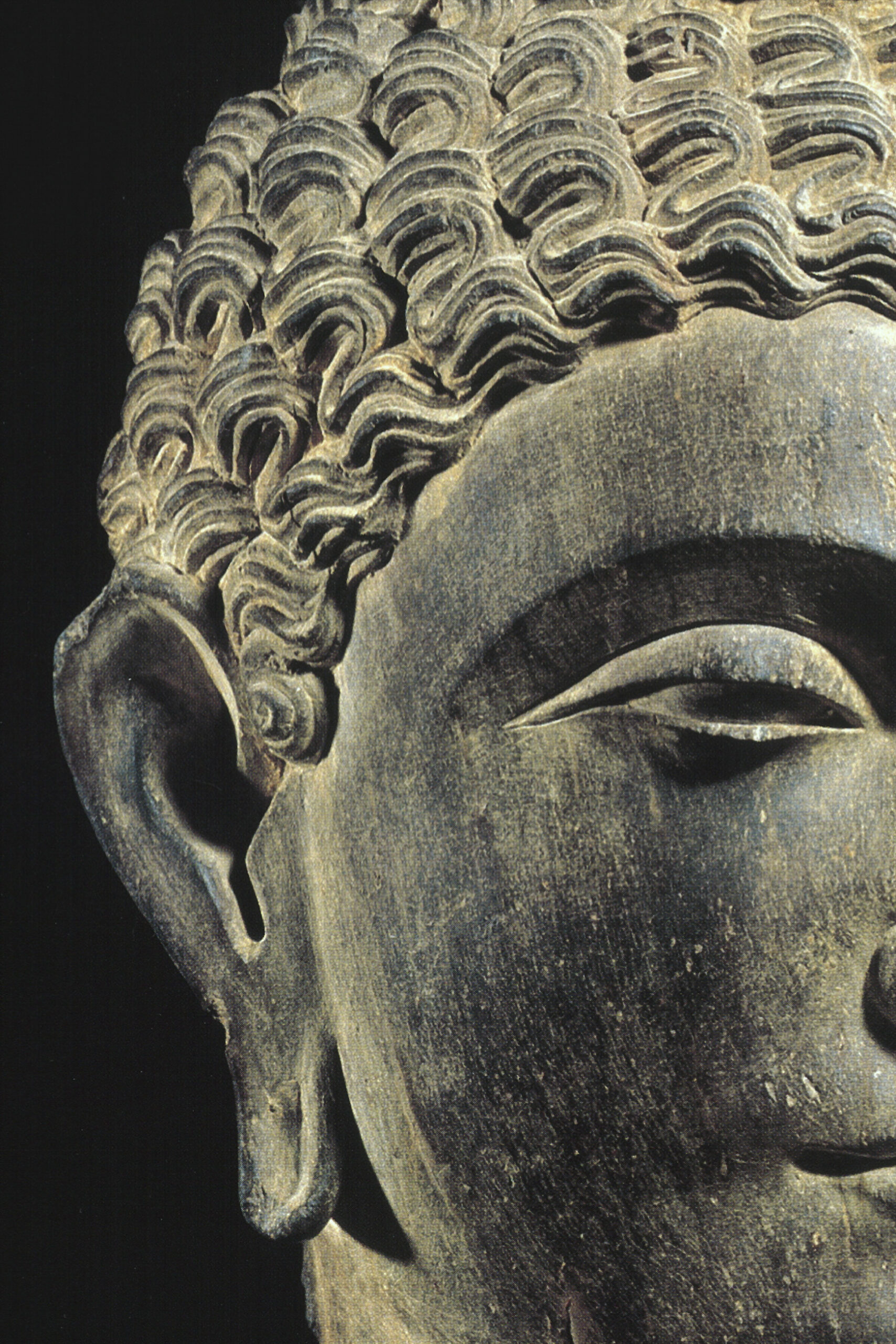
This sculpture portrays Avalokitèsvara, the bodhisattva of compassion. The present bronze portrays the figure seated in virasana, which is rare given that the majority of surviving Avalokitèshvara portraits made in Yunnan are depicted standing. The 34 remaining slender arms (there were 38 originally) radiate around Buddha’s head, adding to its high-powered and almost primitive energy. This extraordinary bodhisattva is executed with great artistic freedom and makes a true masterpiece of tantric Buddhist art.
Sold to the George Ortiz collection. Now in the Asian Civilisations Museum, Singapore
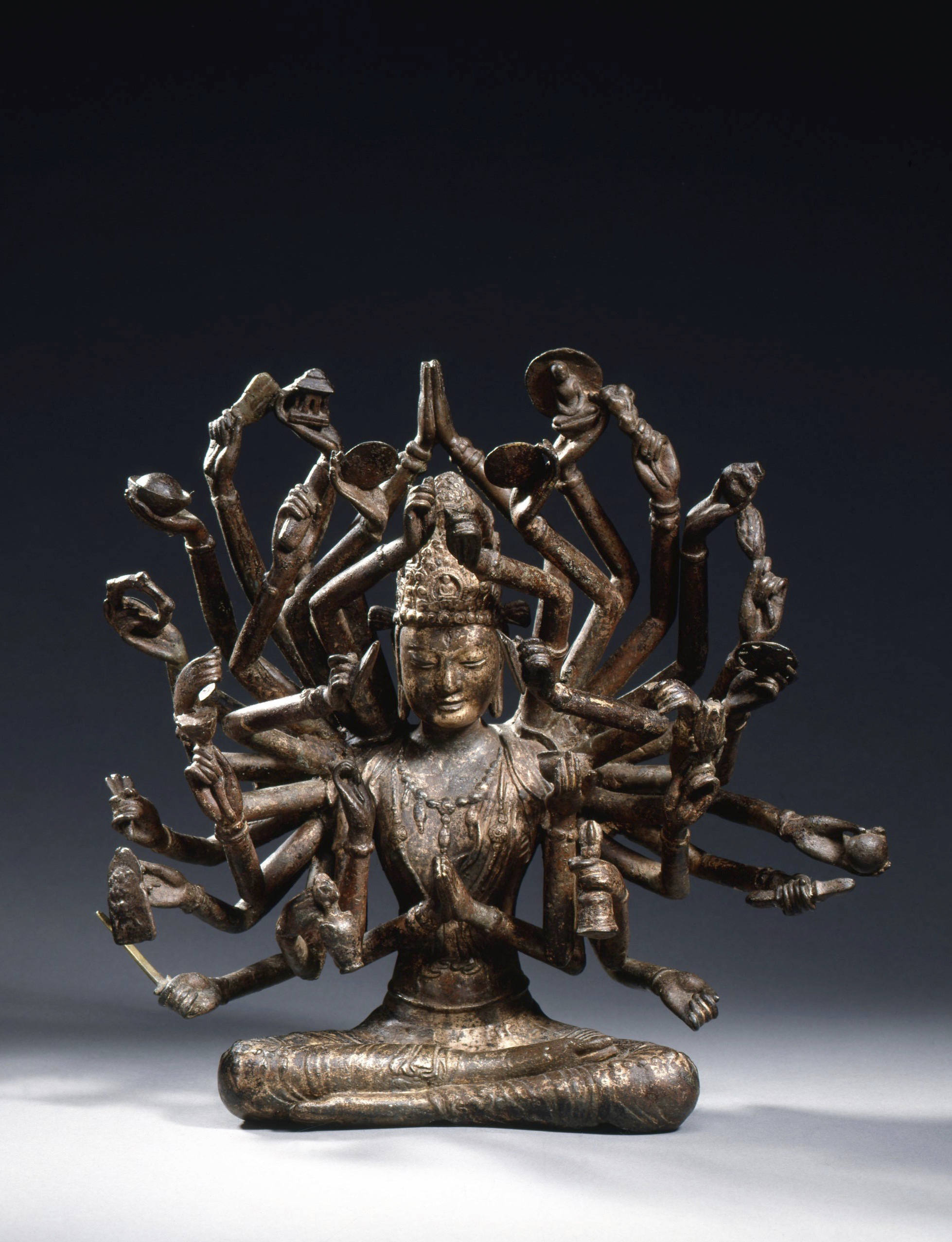
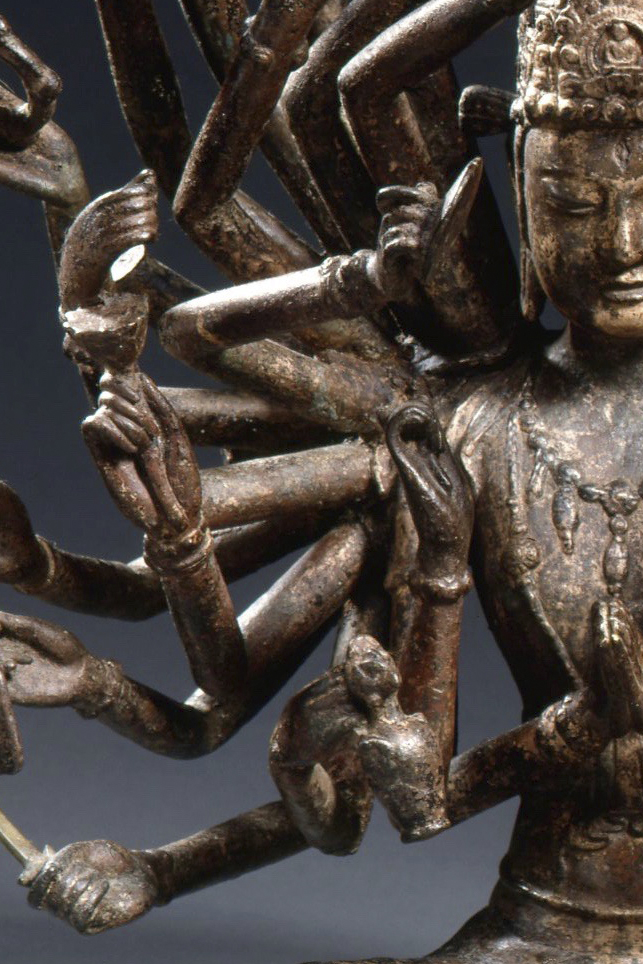
The vajra is a ritual mythical weapon that represents indestructability and incredible force. A vajra is depicted on the lotus throne of this sculpture and identifies the figure as Buddha Vajrasana. Whilst this Buddha was originally found in Tibet, it showcases strong influence of eastern Indian artistic traditions. The sophisticated technical execution of the casting is consistent with bronzes from Pala, India. Indian pilgrims occasionally took bronzes to Tibet which inspired early Tibetan Buddhist art and the present Buddha is likely to be one of such examples. The sculpture is comparable to only a few examples in public collections, one in the British Museum and another in the North Simon Museum.
Sold to a private collection, Italy
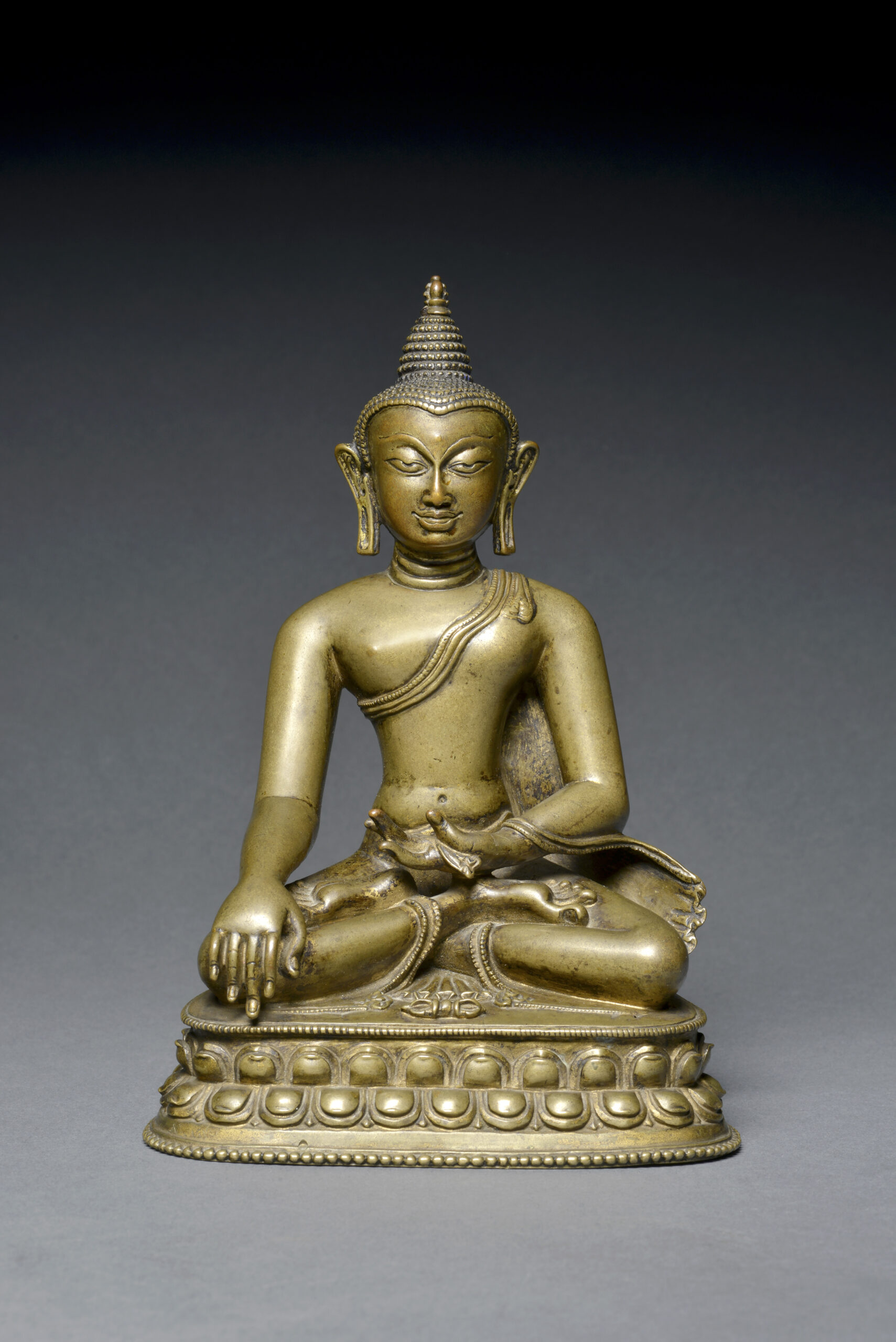
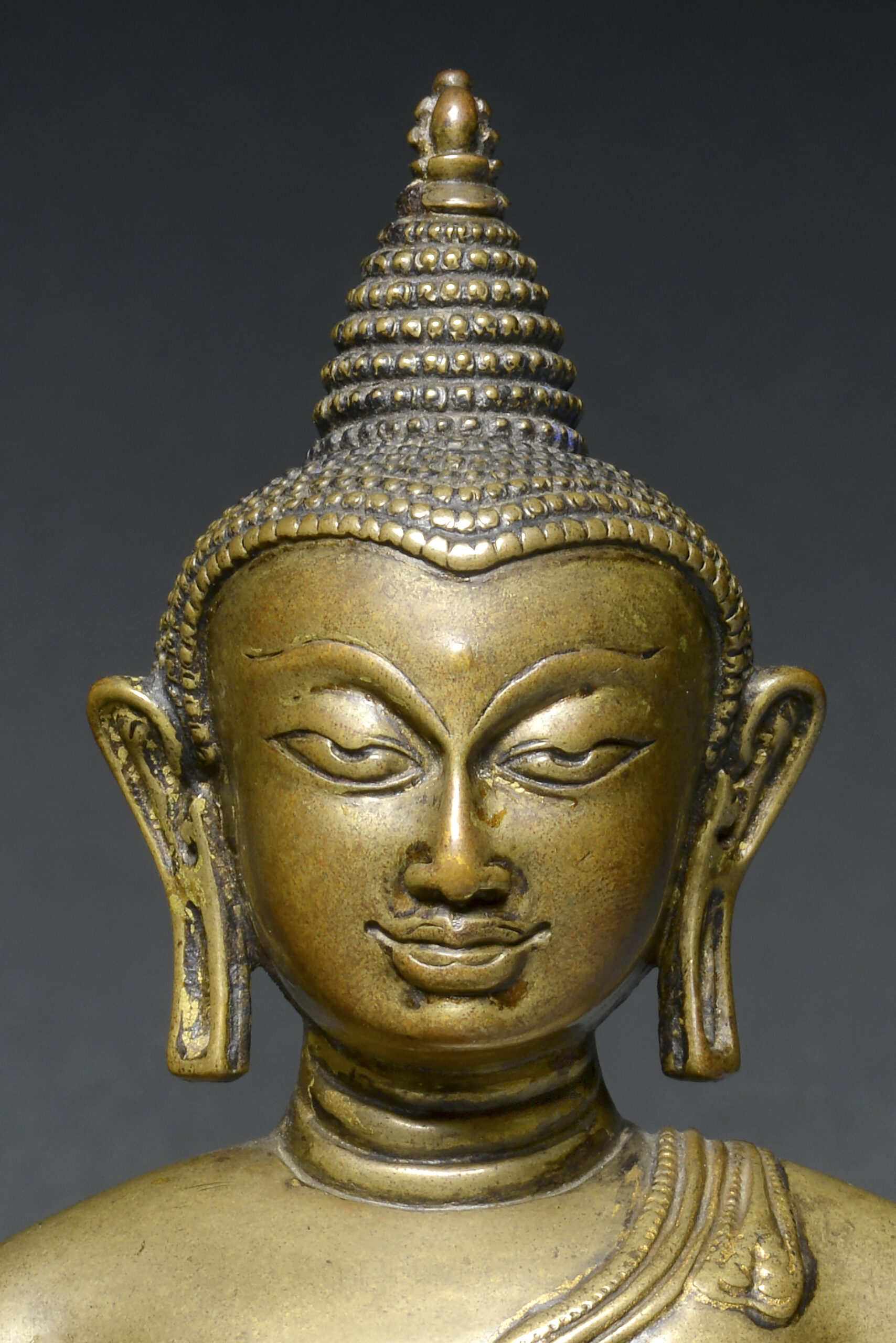
Manjusri, a Buddhist deity associated with prajna (insight, wisdom), is one of the most important bodhisattvas in Mahayana literature. The present statue portrays the deity with exceptional sophistication and makes a fitting commission for a Tibetan monastery. The bronze reveals clear influence of Nepalese sculptural traditions of the early Malla kingdom. The metal alloy and technical execution of the casting suggest that the bronze was made by Nepalese Newari craftsmen. This important image of Manjusri has a majestic presence and the sensuous modelling of the youthful physique demonstrate the masterful quality of this bronze.
Sold to a private collection, United Kingdom
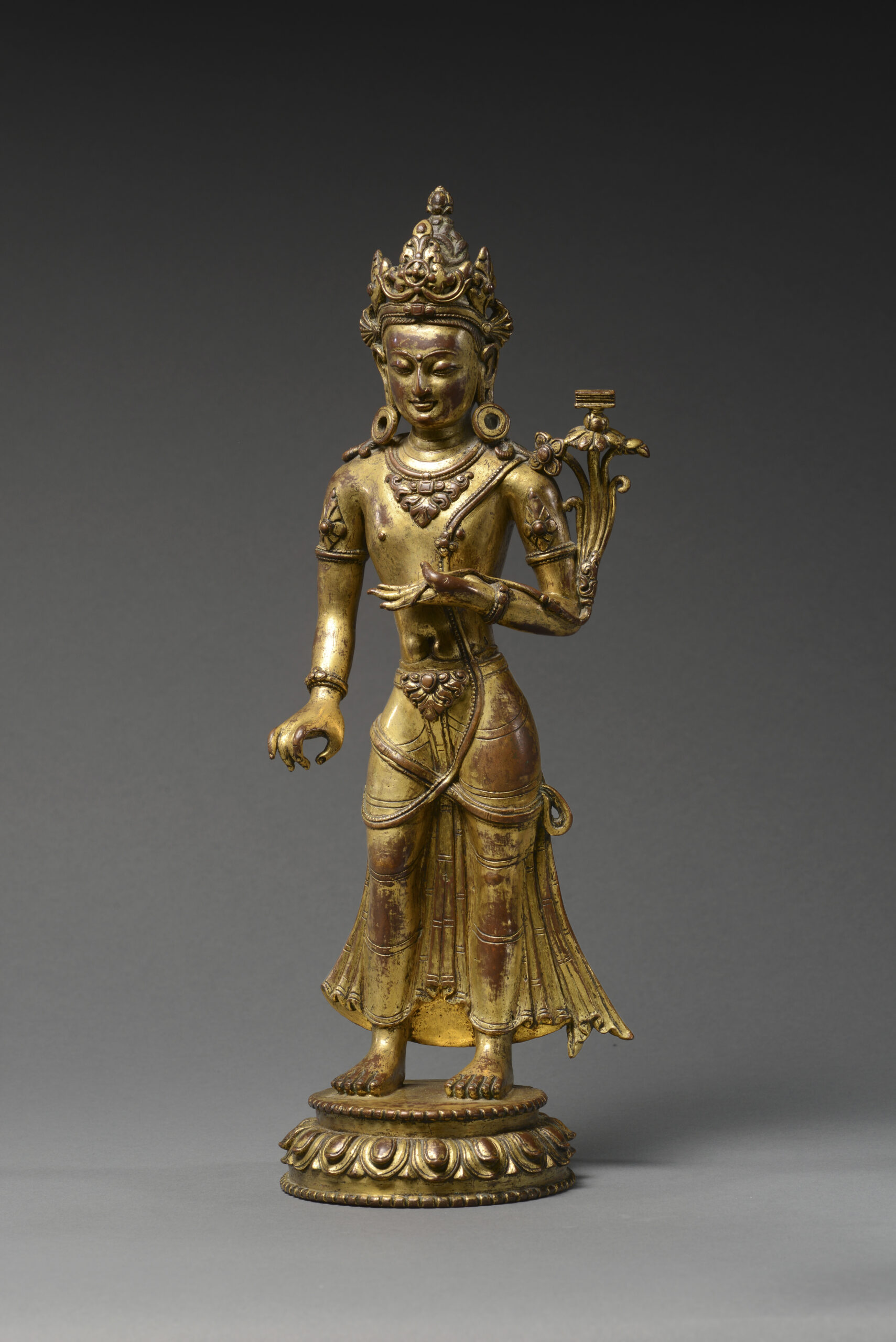


Buddharaja refers to the historical Buddha who is attributed the title of Rajadhiraja, meaning King of Kings. This rare type of Buddha image portrays the historical figure wearing a crown, alluding to the early phase of Buddha’s life when he lived as Prince Siddhartha, son of a wealthy ruler. The kingdom of Ayudhia (1350-1767) ruled throughout present-day Thailand and was one of the wealthiest and most powerful states in Southeast Asia. This life-sized standing figure of the historical Buddha is a classic example of the Ayudhia school: the stable clean casting, the stylised features of the face, the detailed crown, and the finely outlined physical shapes with seemingly transparent garments are all typical Ayudhia characteristics. This important and extremely rare Buddharaja portrait is one of the finest known examples within its genre.
Sold to a private collection, USA
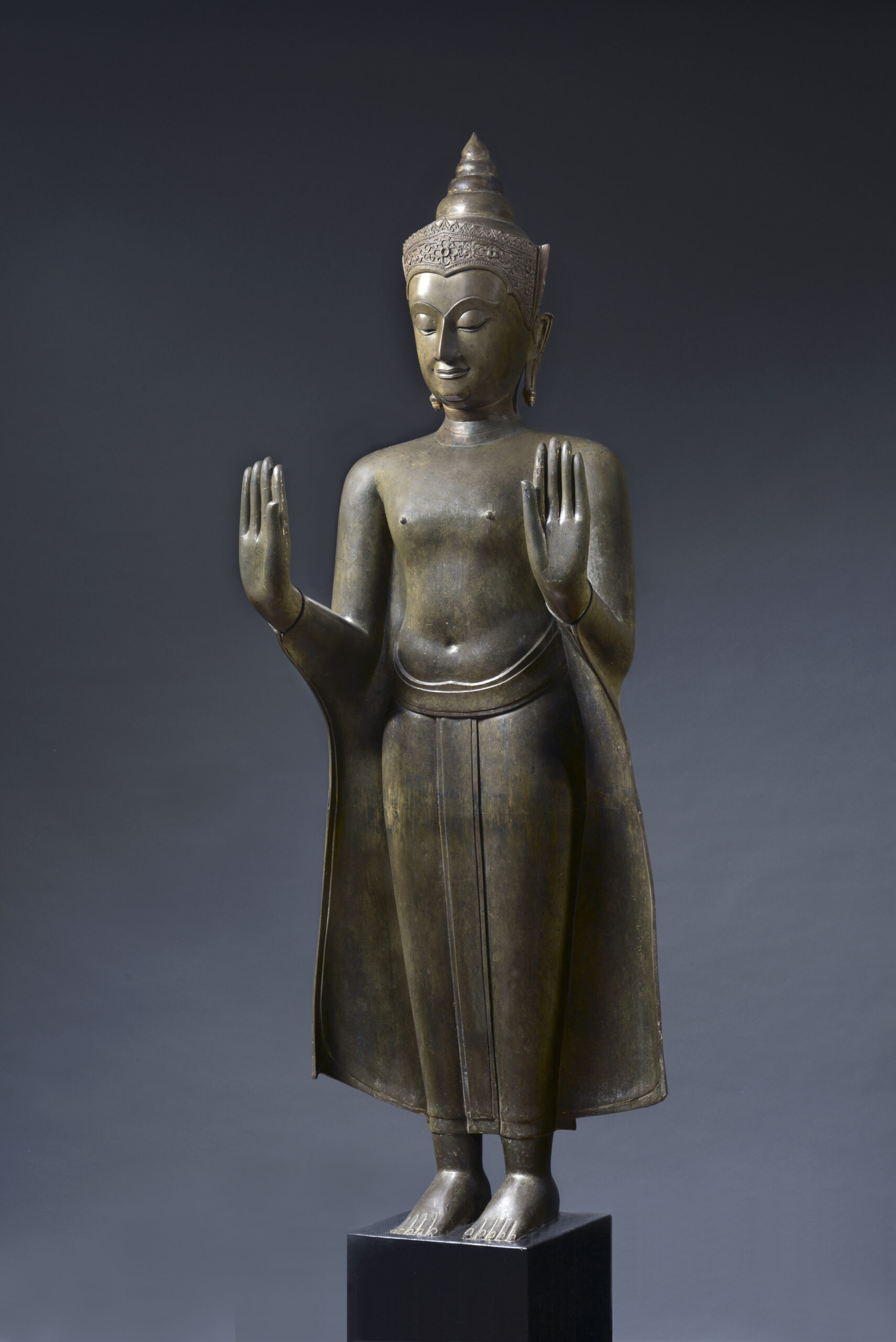
Sadaksari is an emanation of Avalokitèsvara, bodhisattva of compassion. This impressive bronze is among the finest portraits of Sadaskari made by the Newari artisans who settled in Central Tibet. The bronze is characterised by beautiful volume, a powerful posture, and masterful jewellery. It is cast in several parts, which is common technique for early Tibetan bronzes. The unsurpassed quality and monumental scale underline the statue’s importance in serving a monastery. The excellent condition and retainment of original gilding is rare and complements the lively and inspired expression of this masterpiece.
Sold to a private collection, USA
